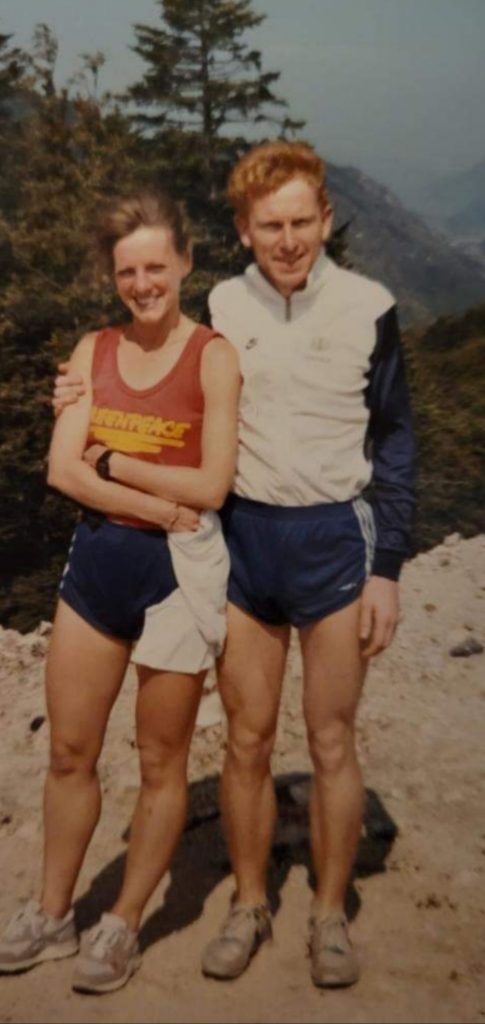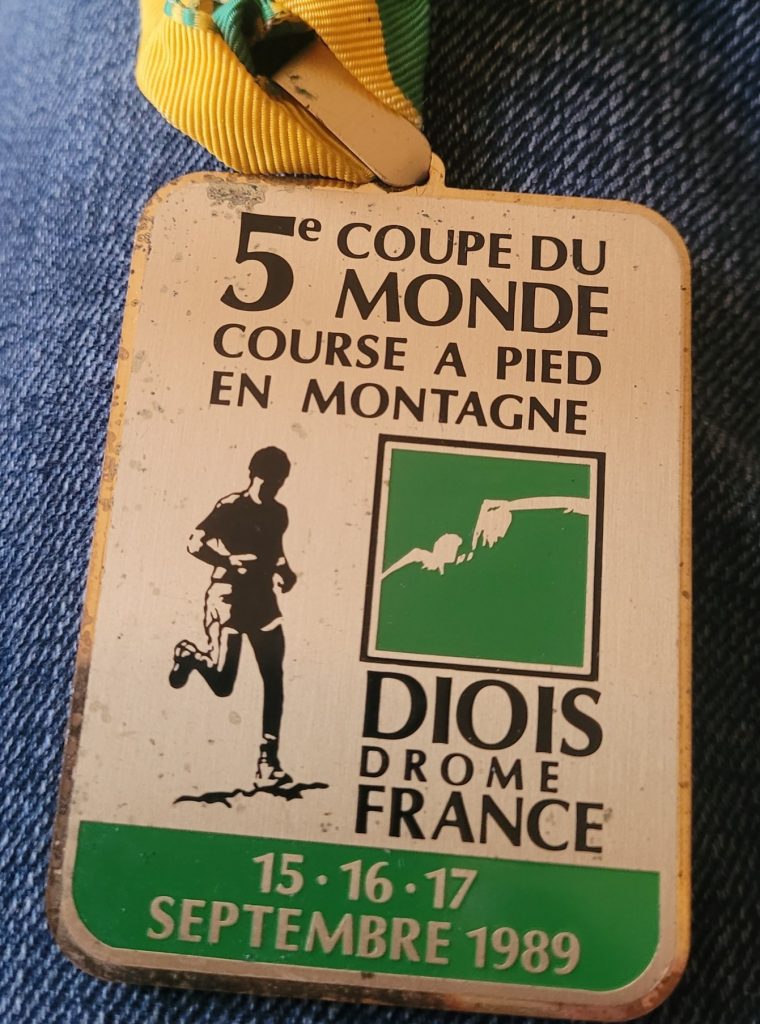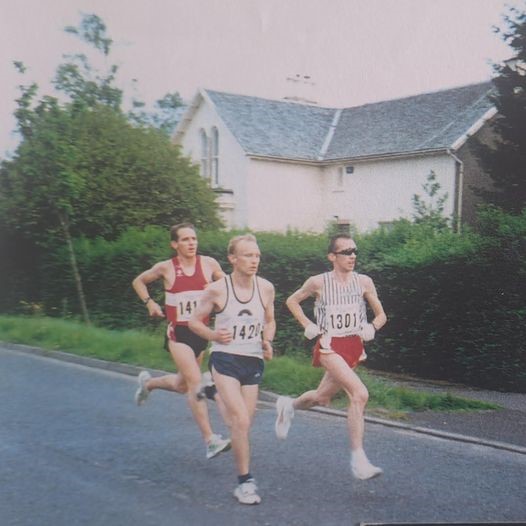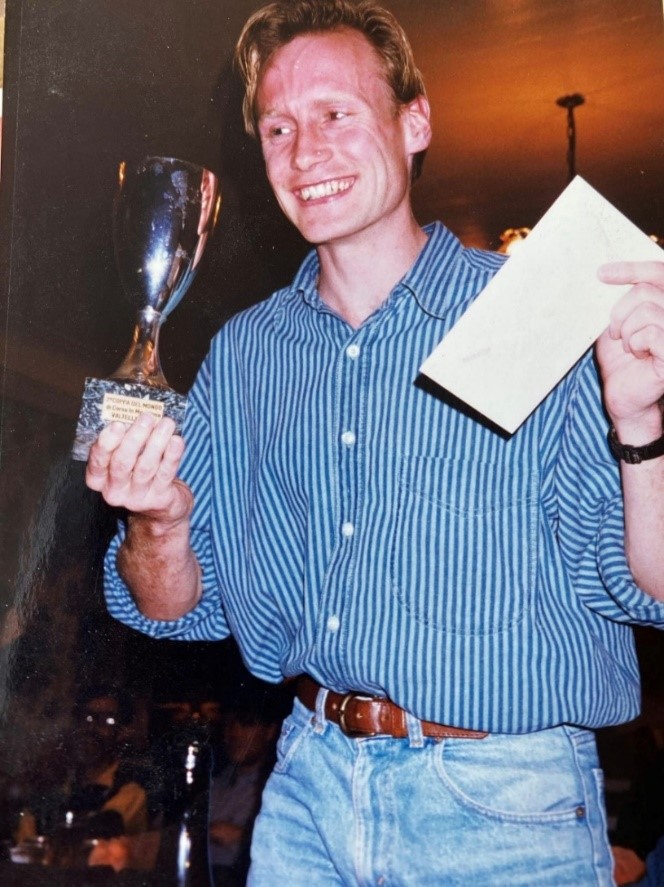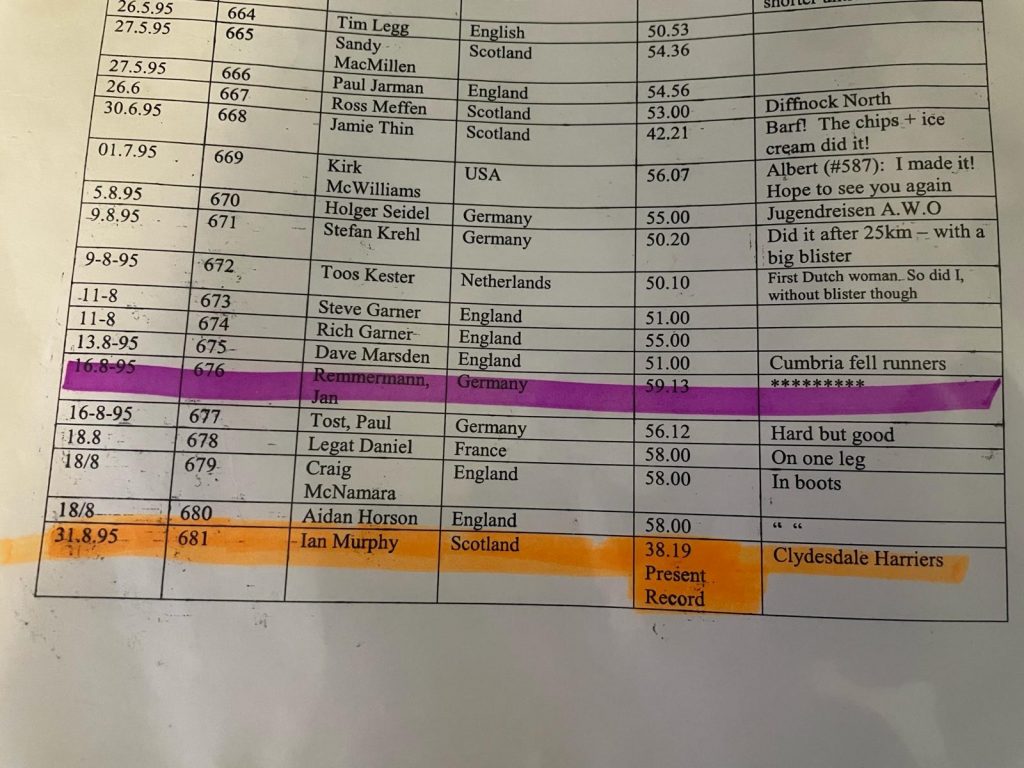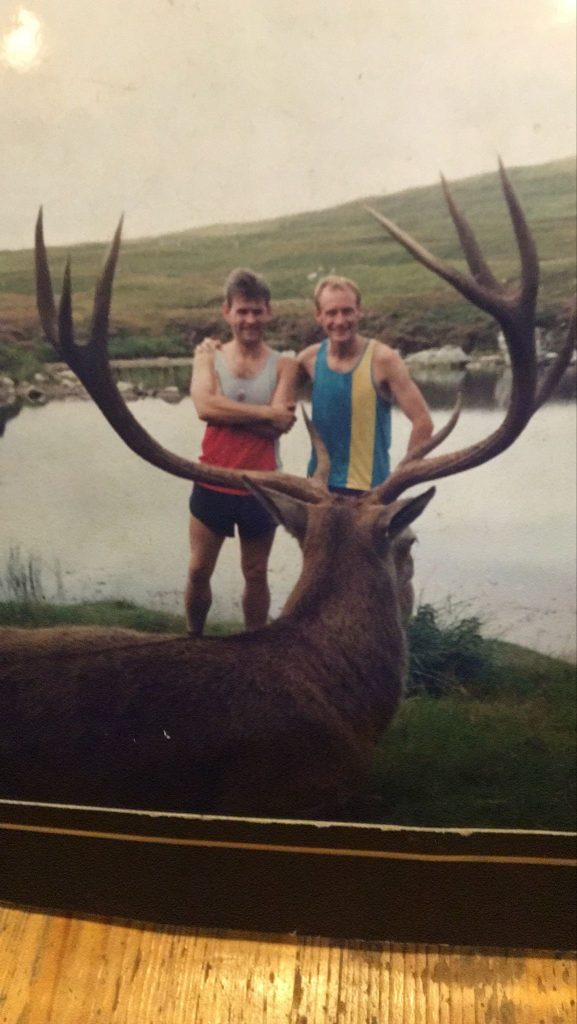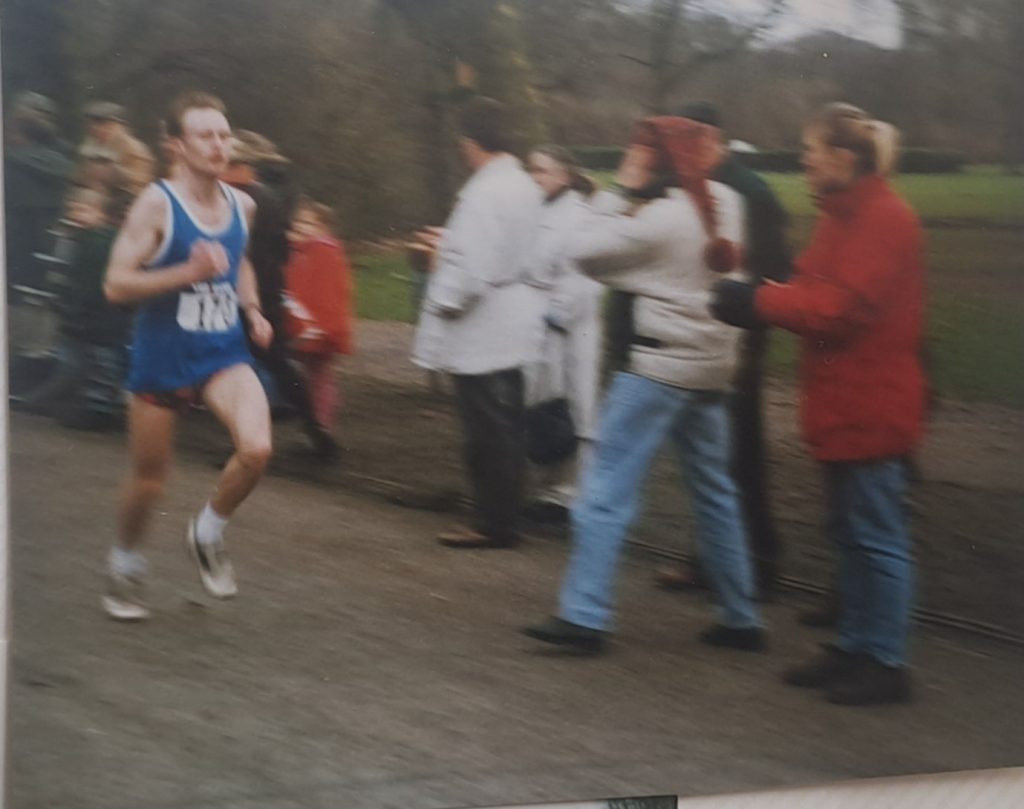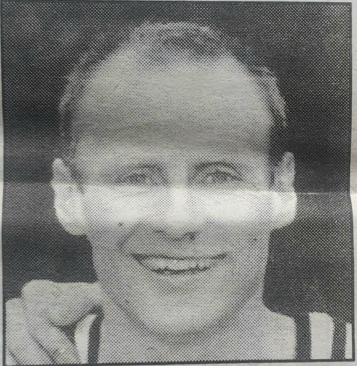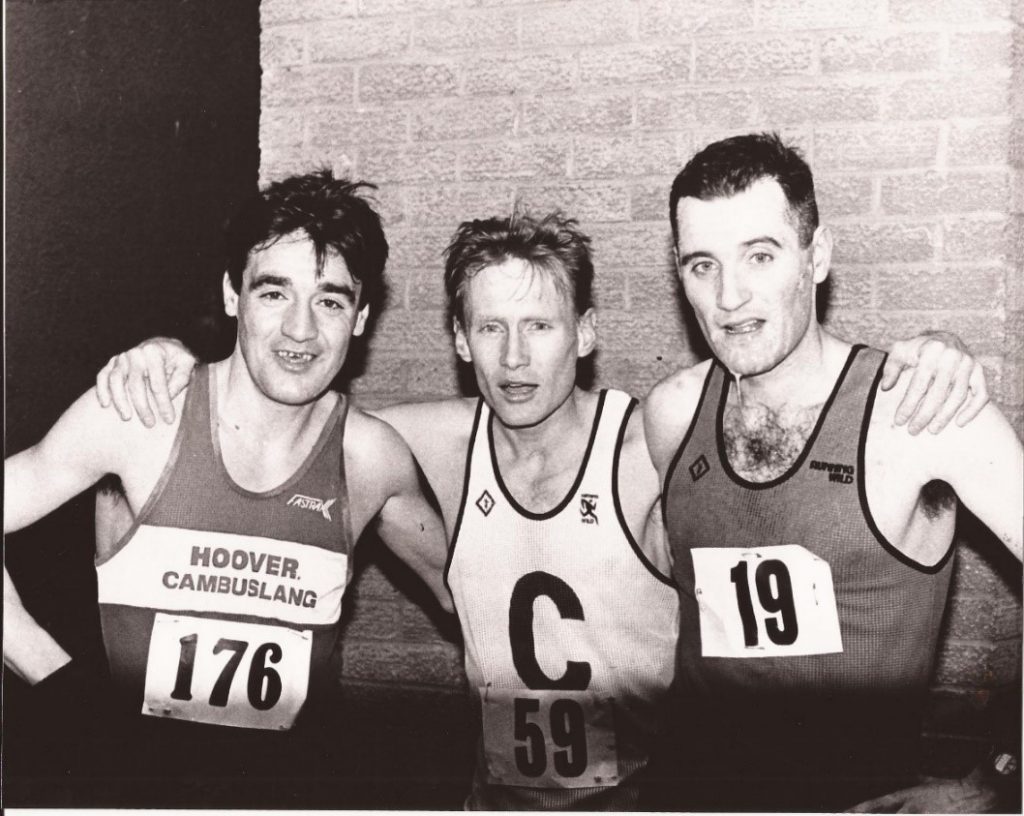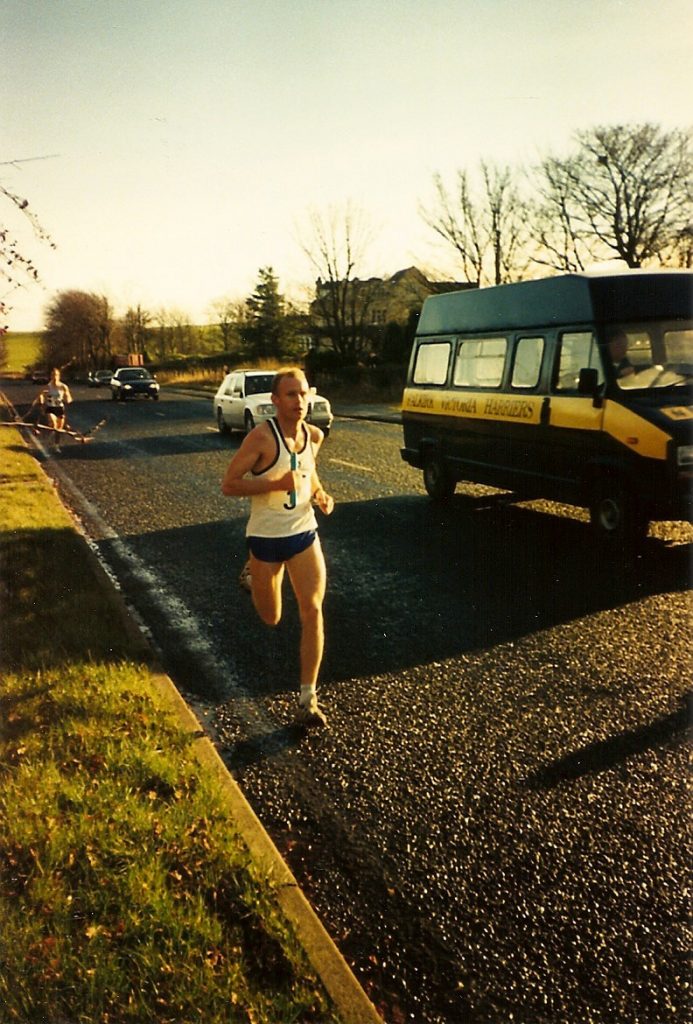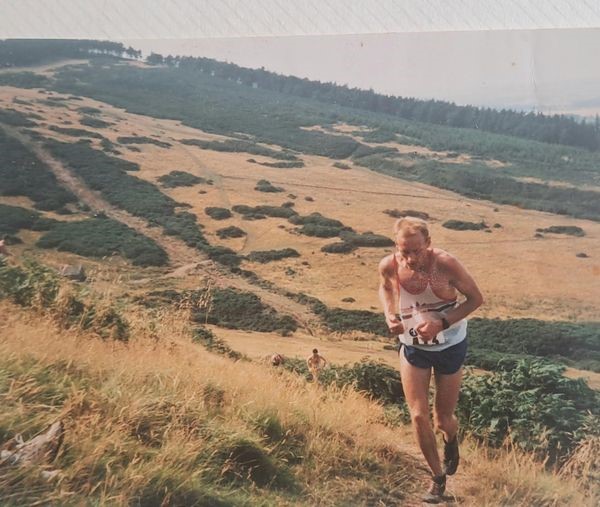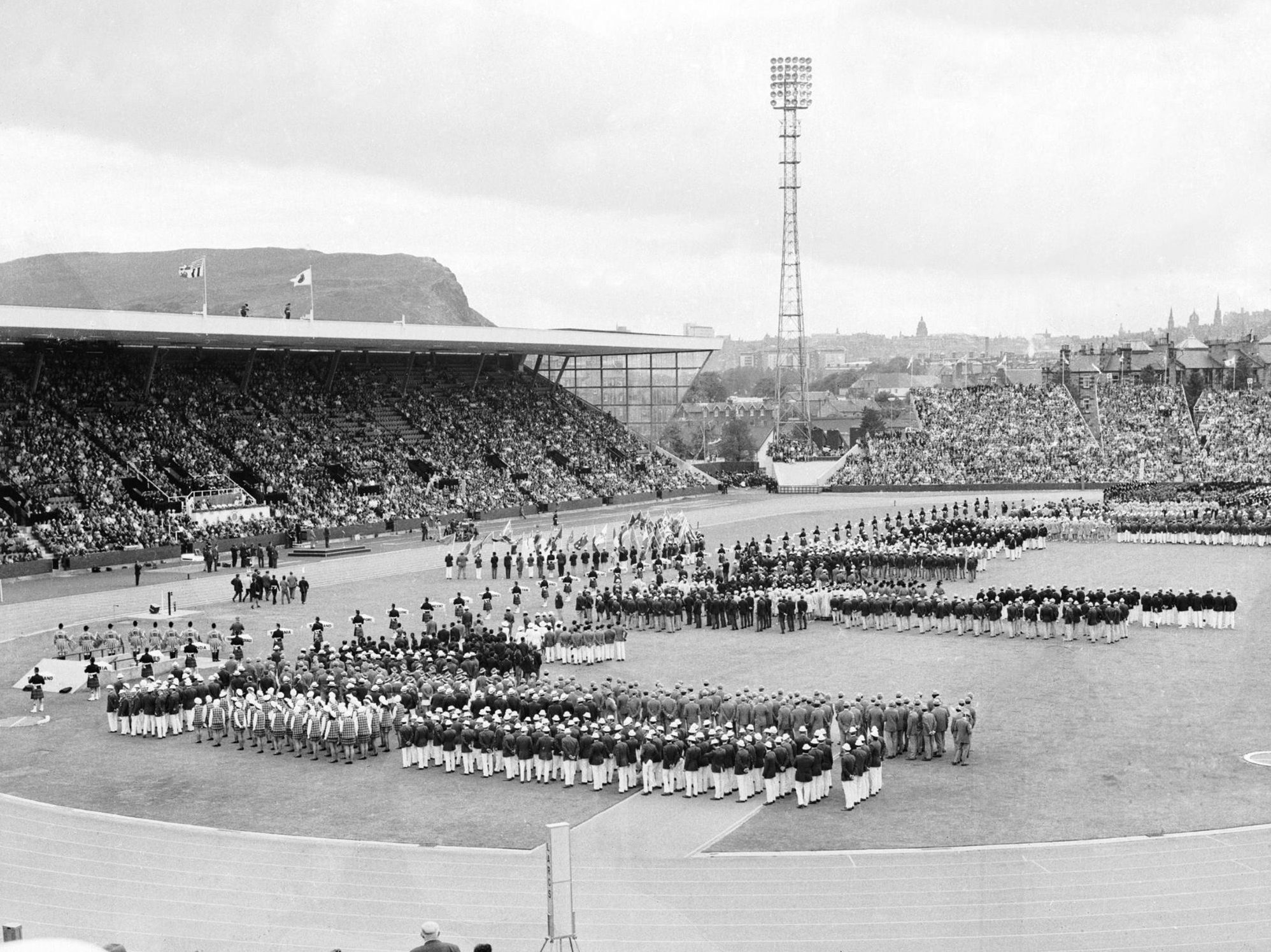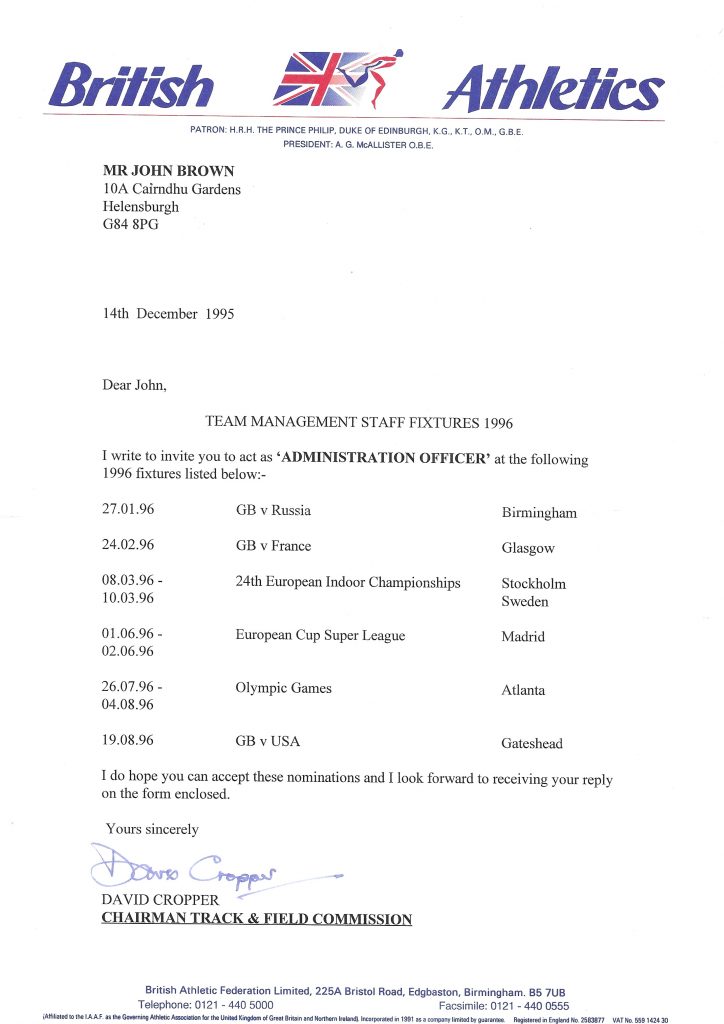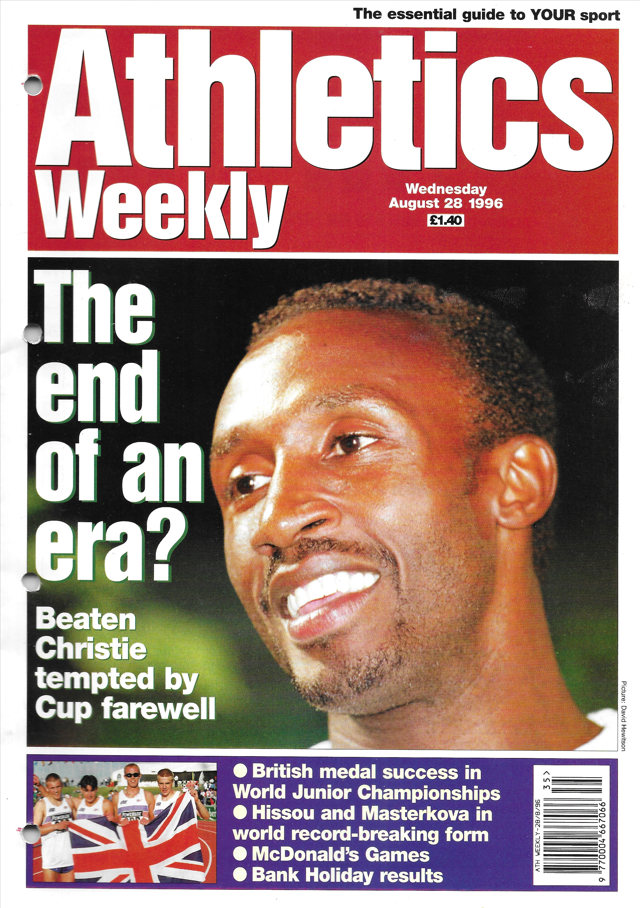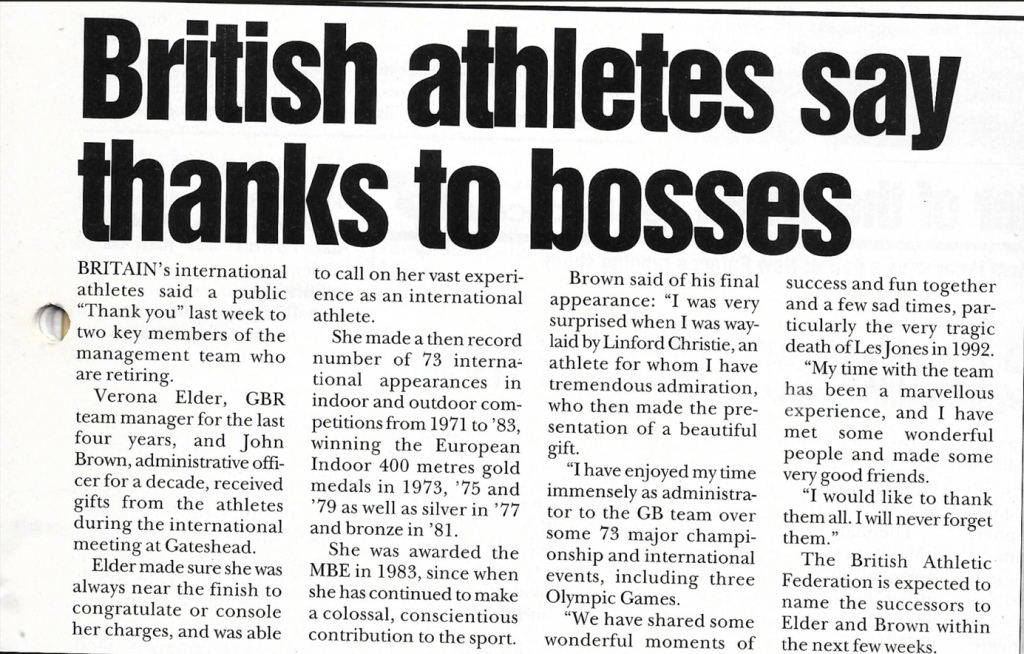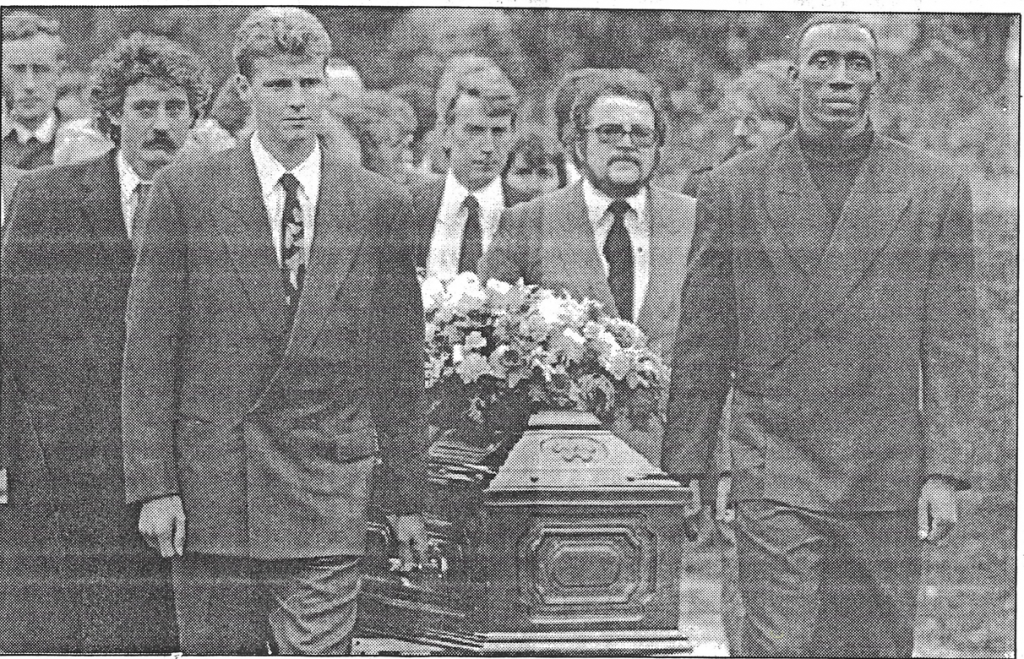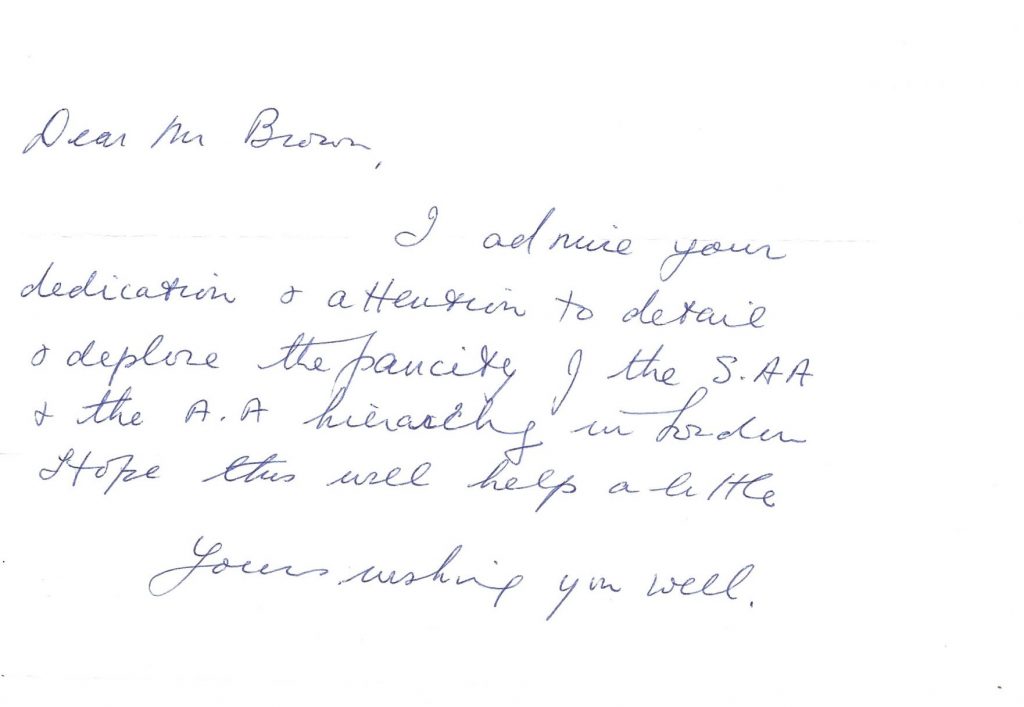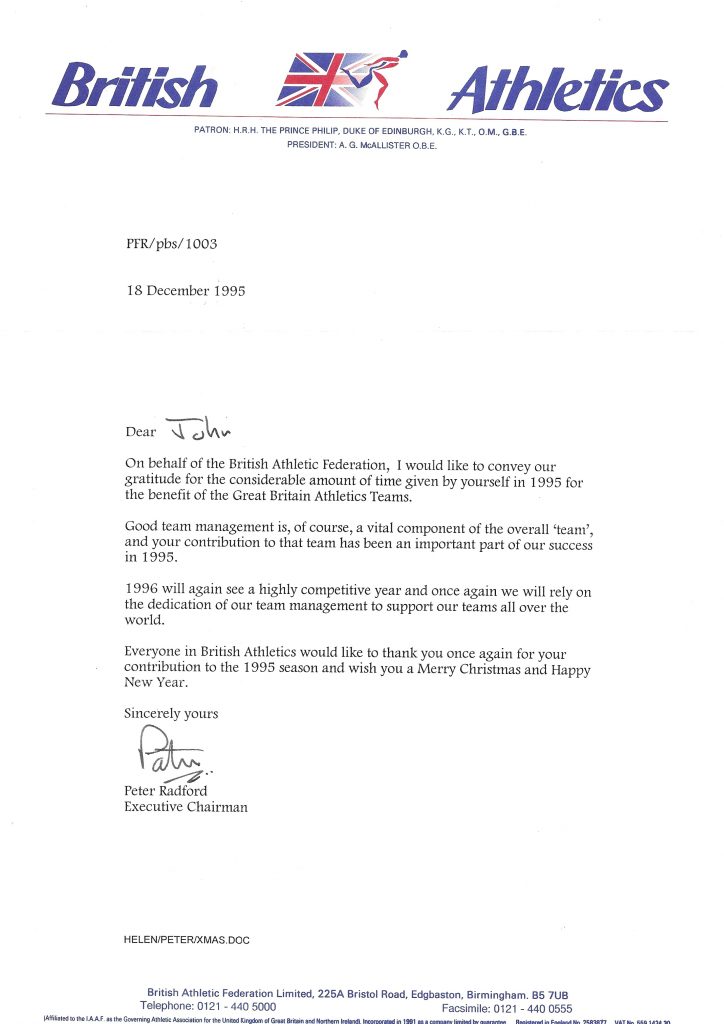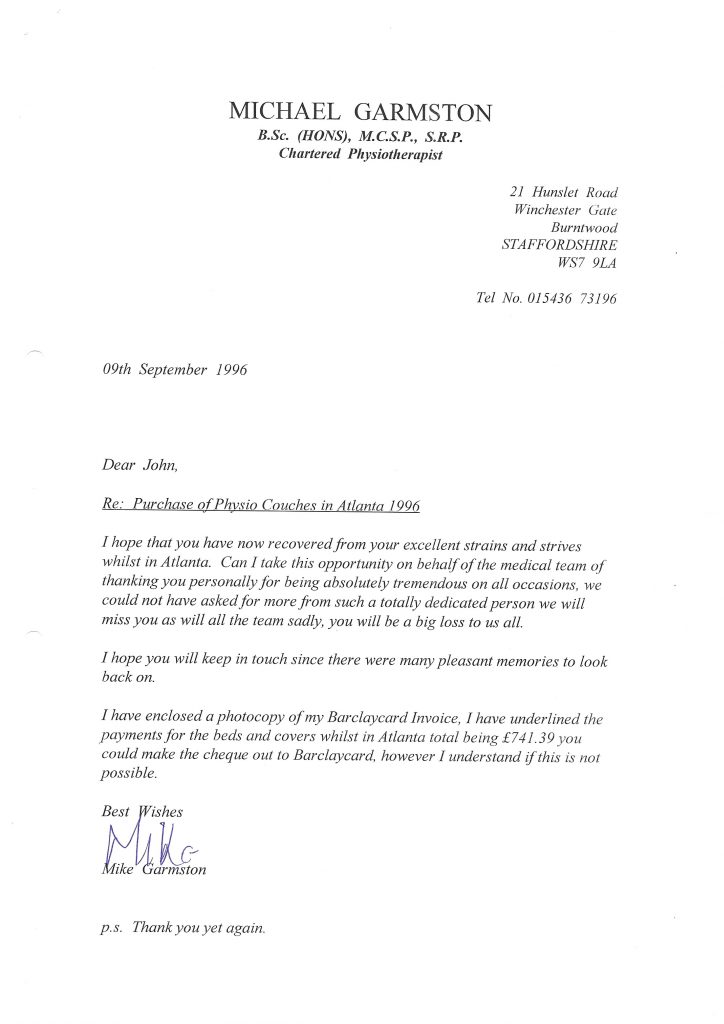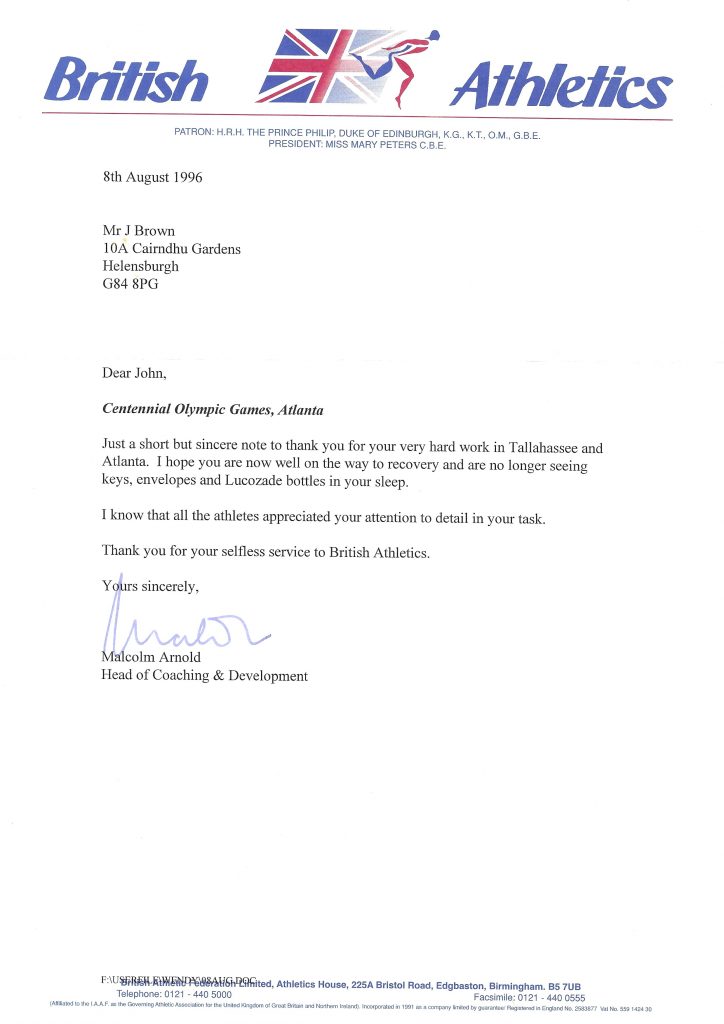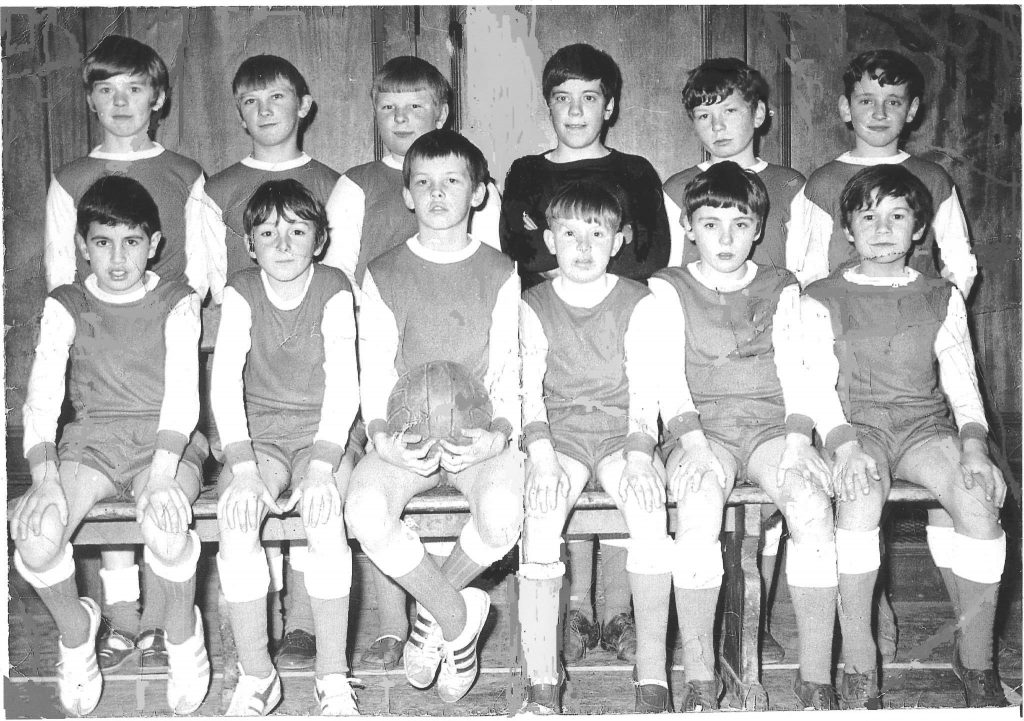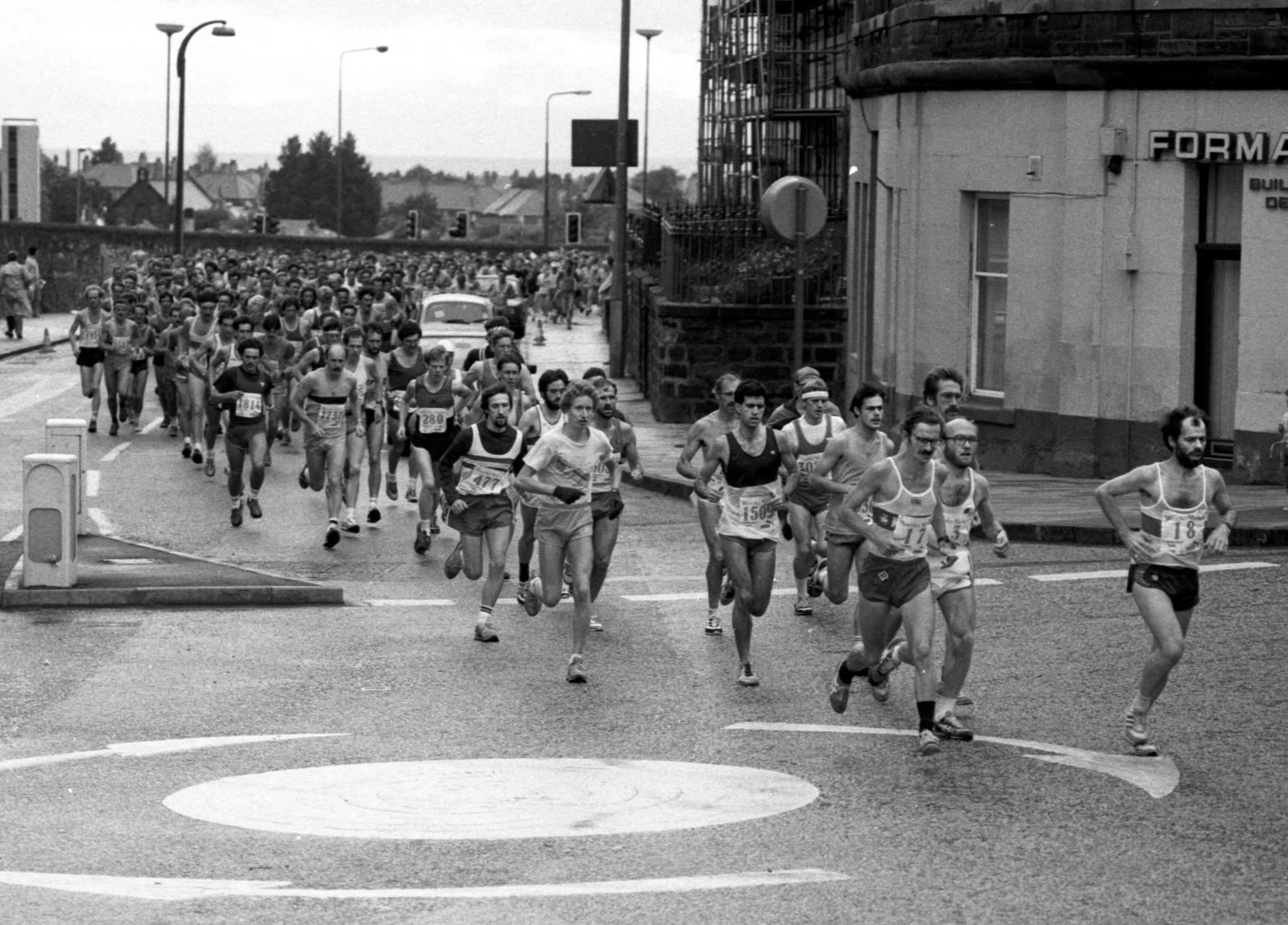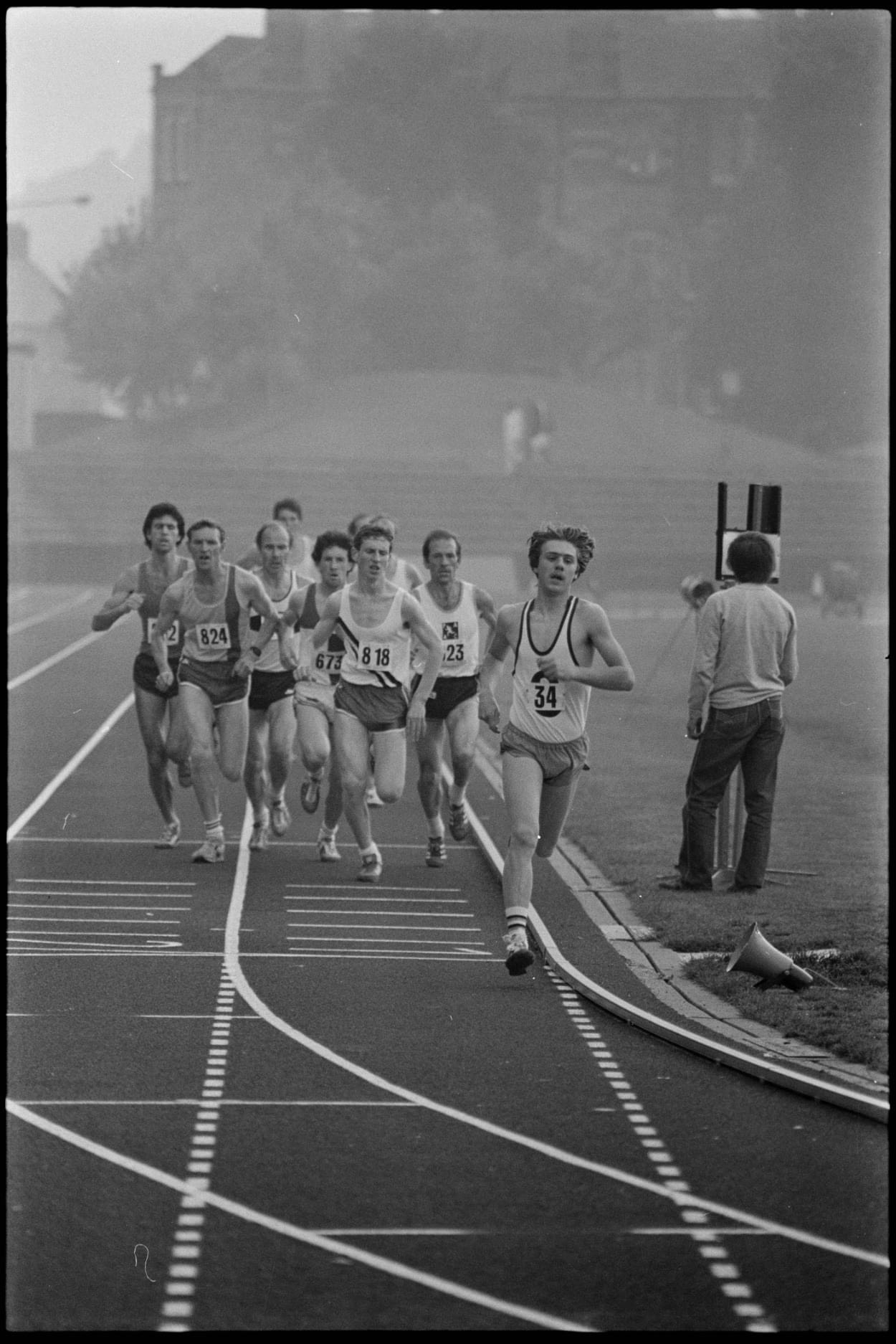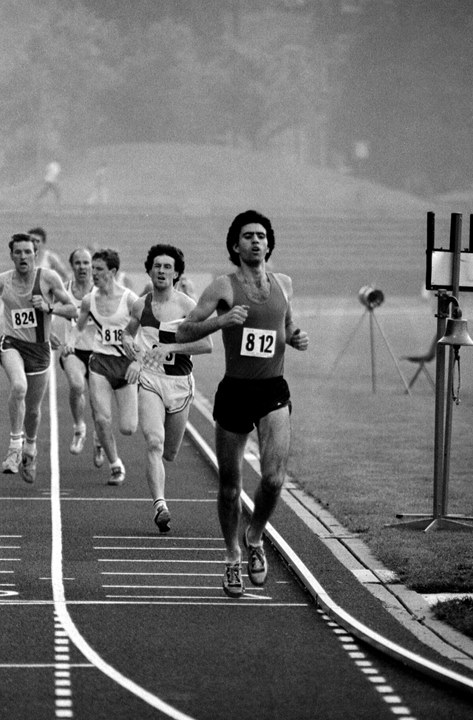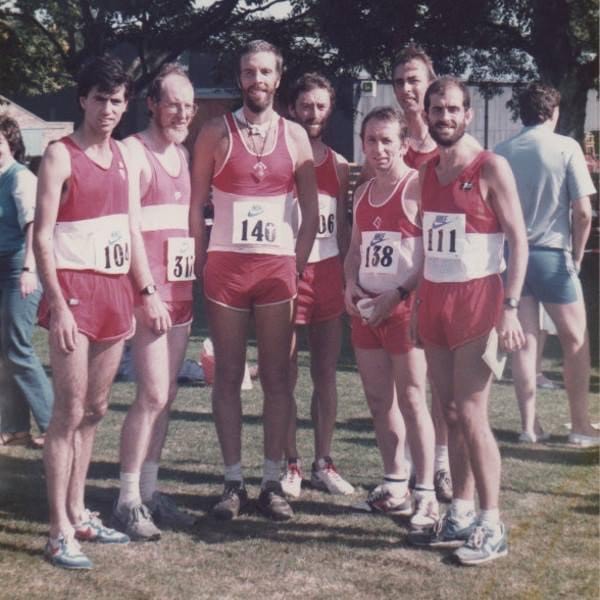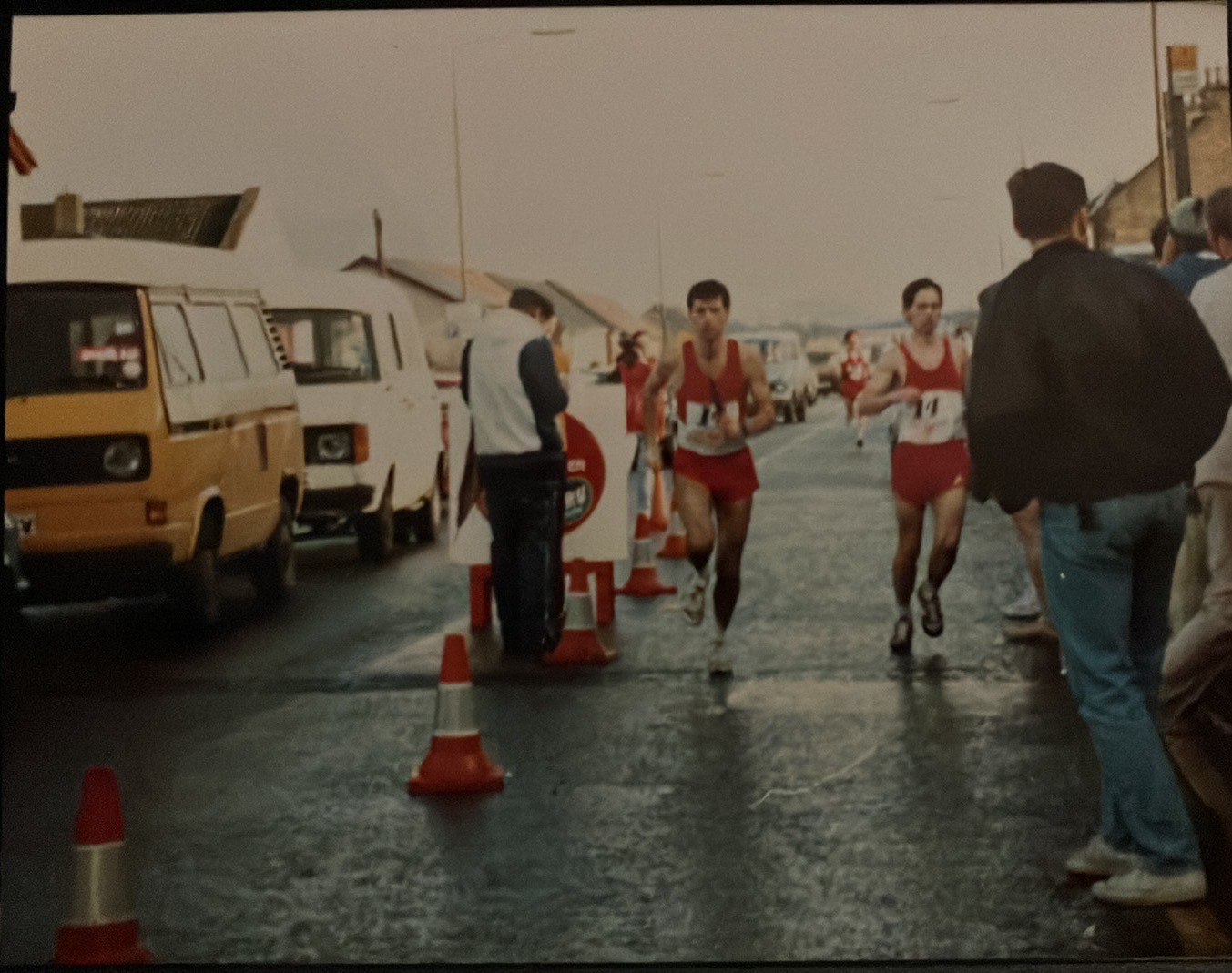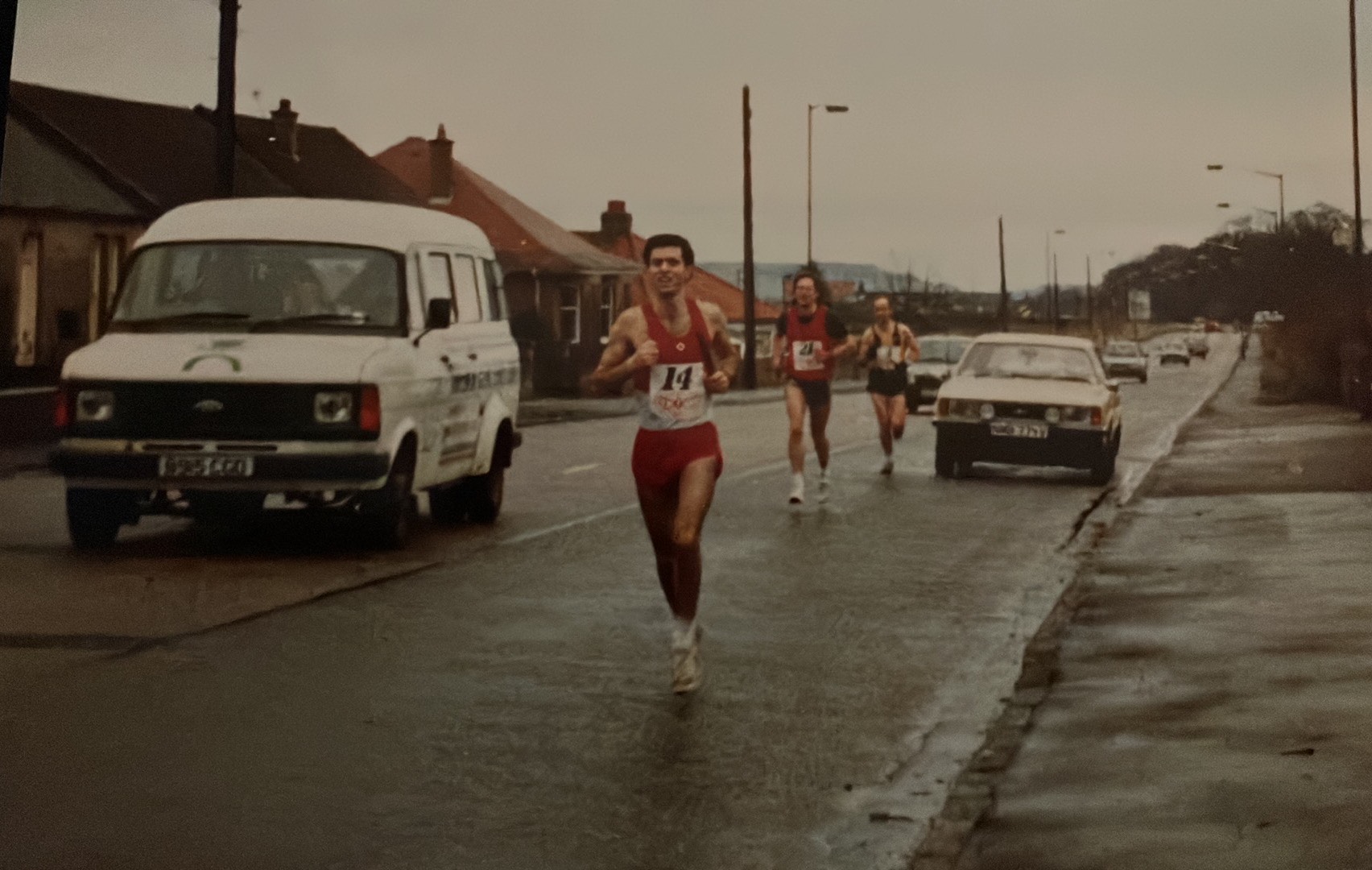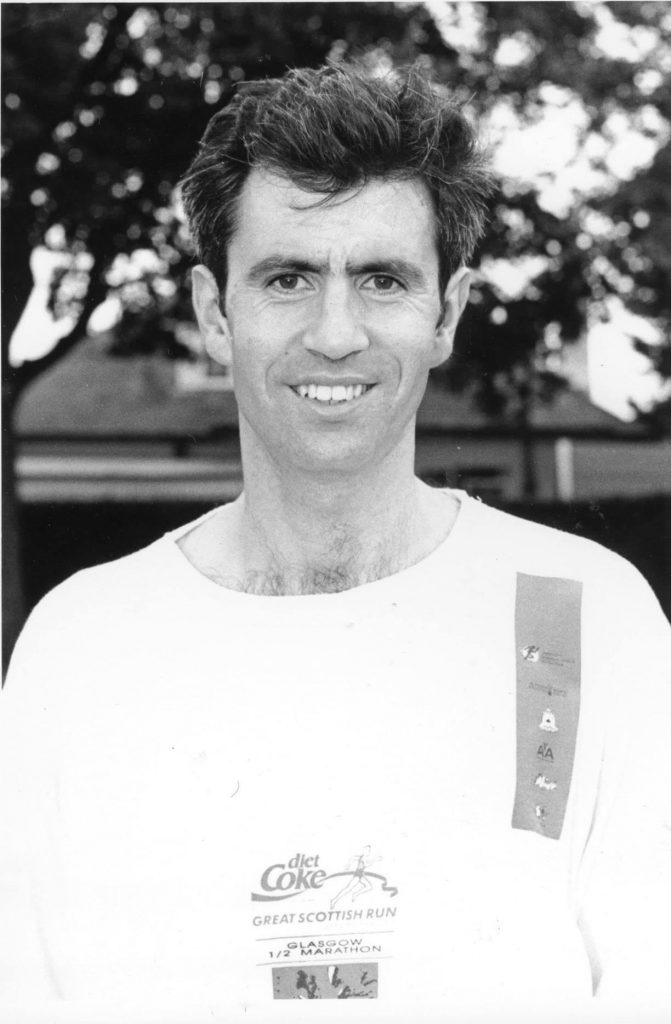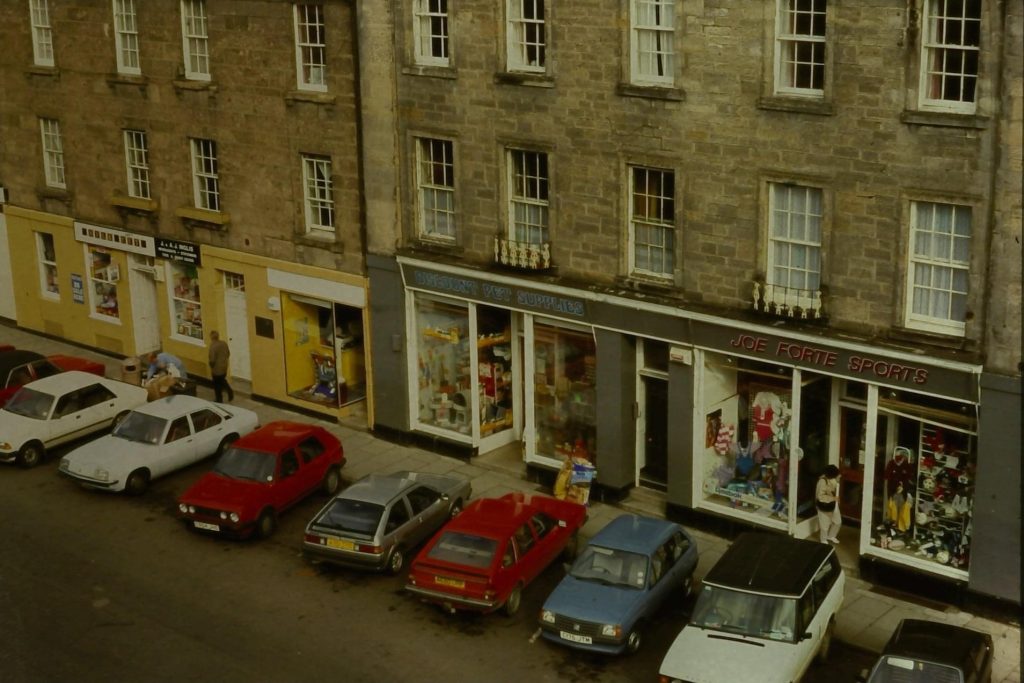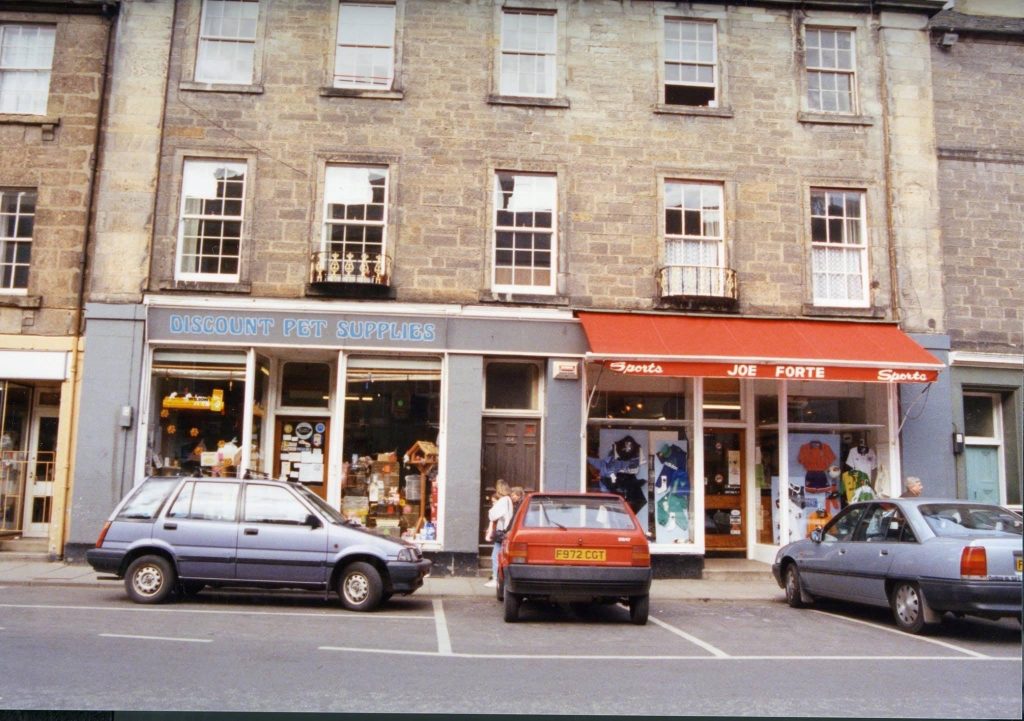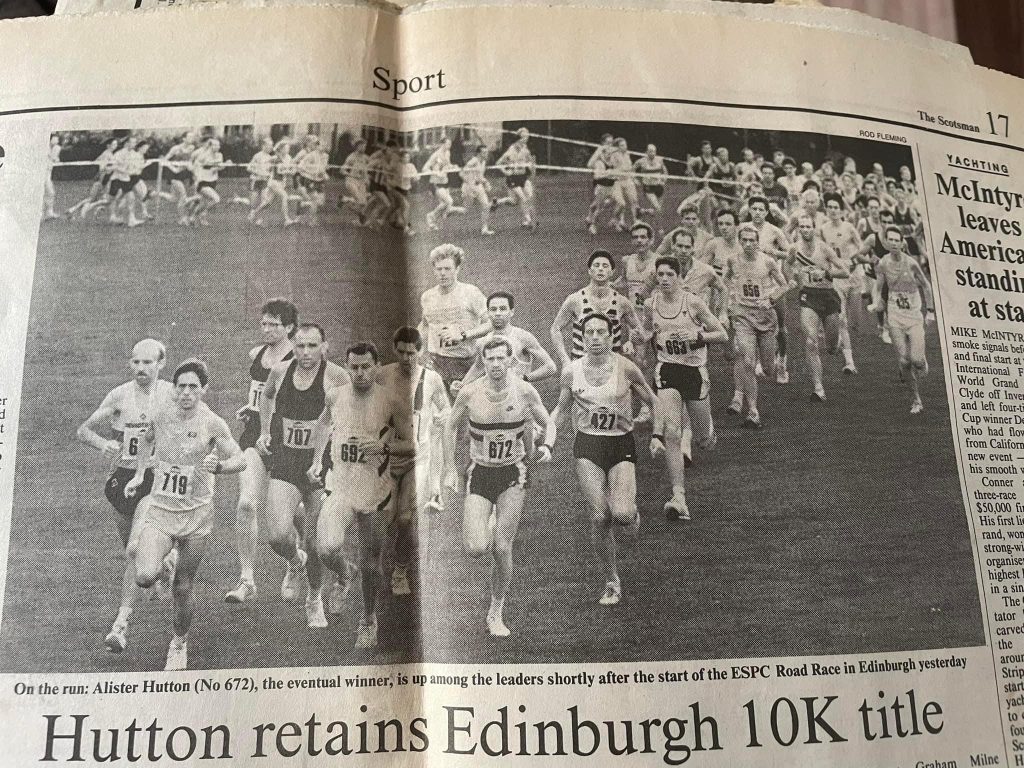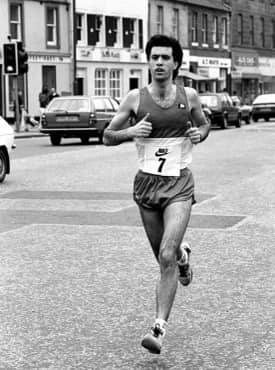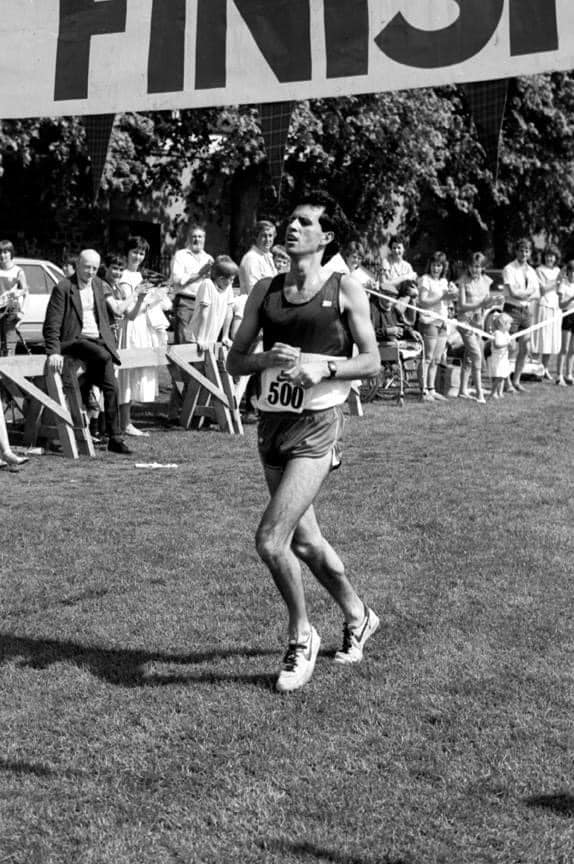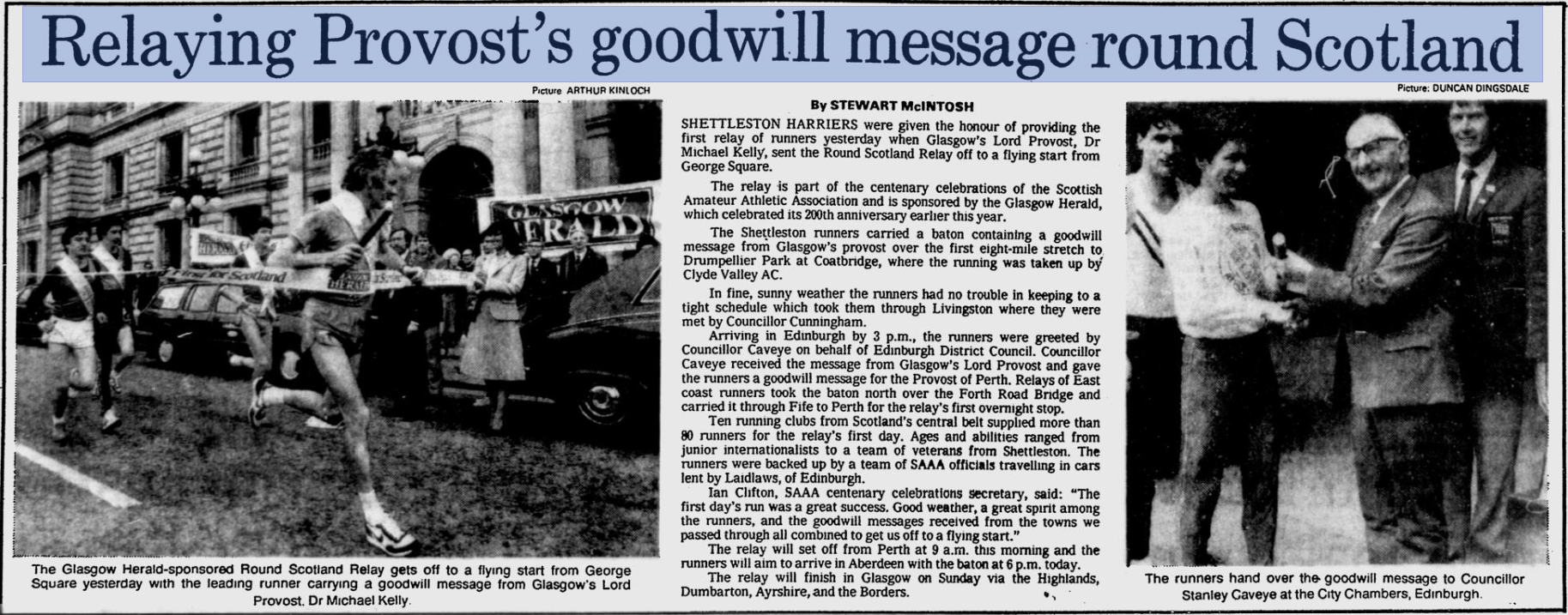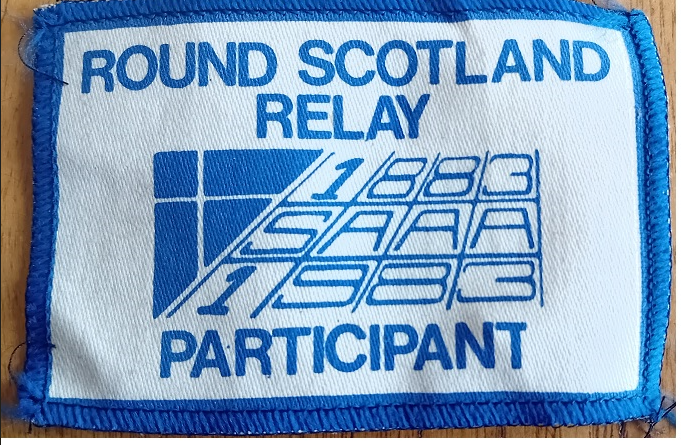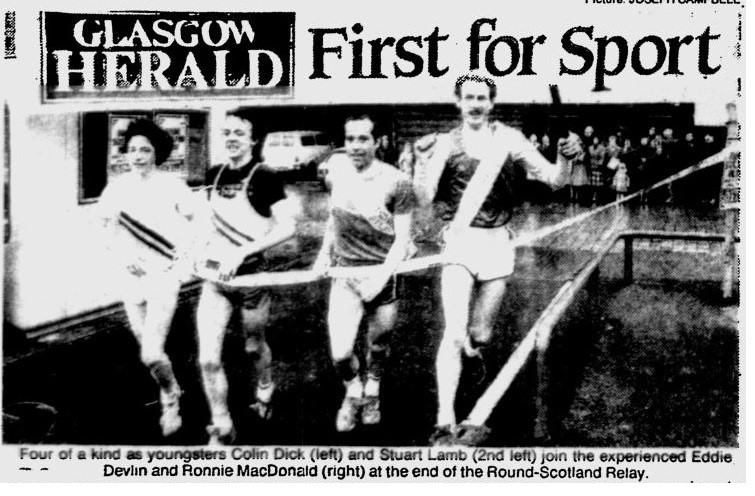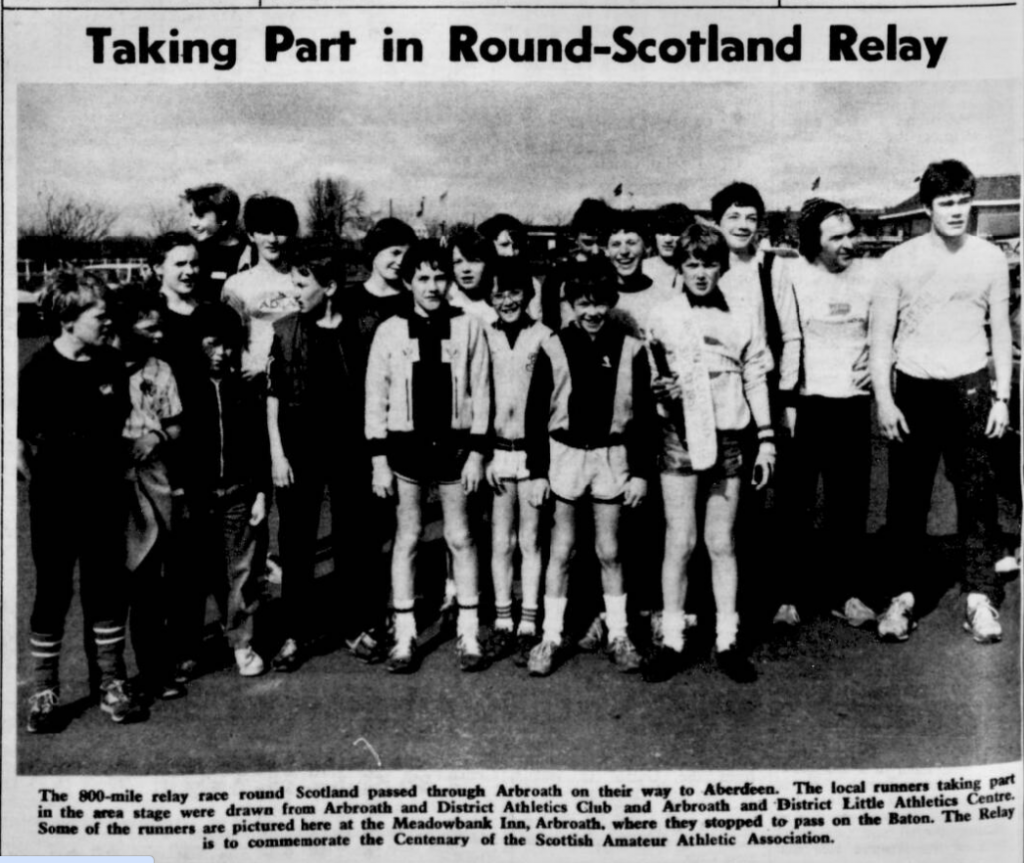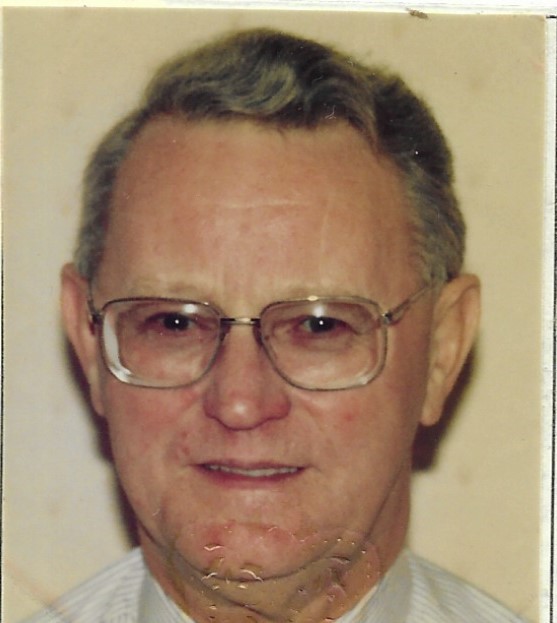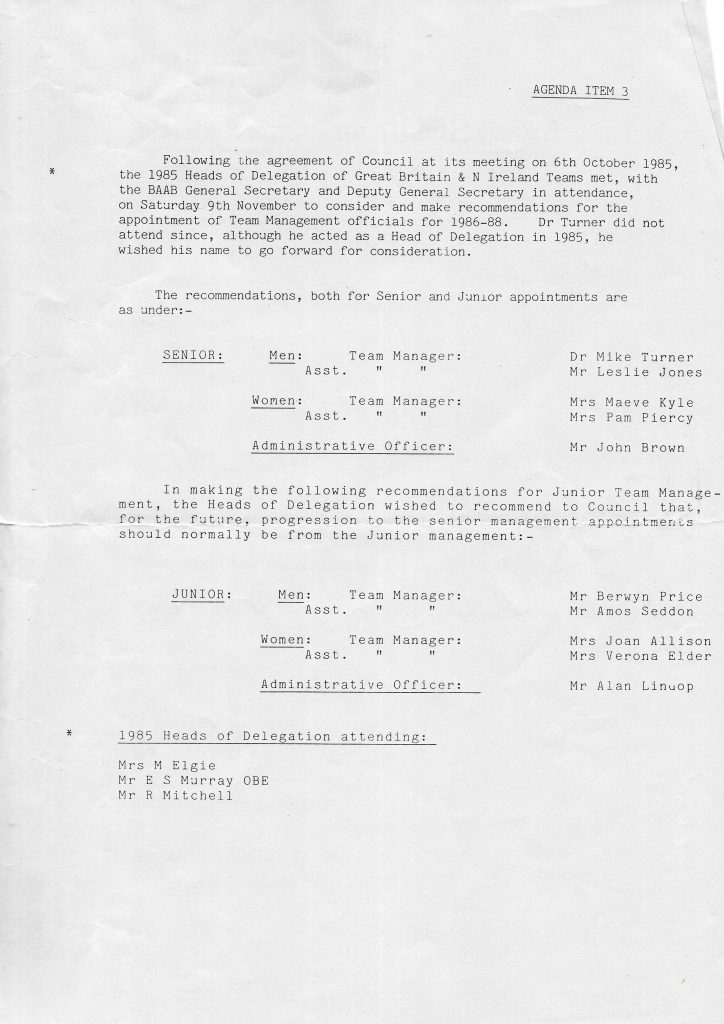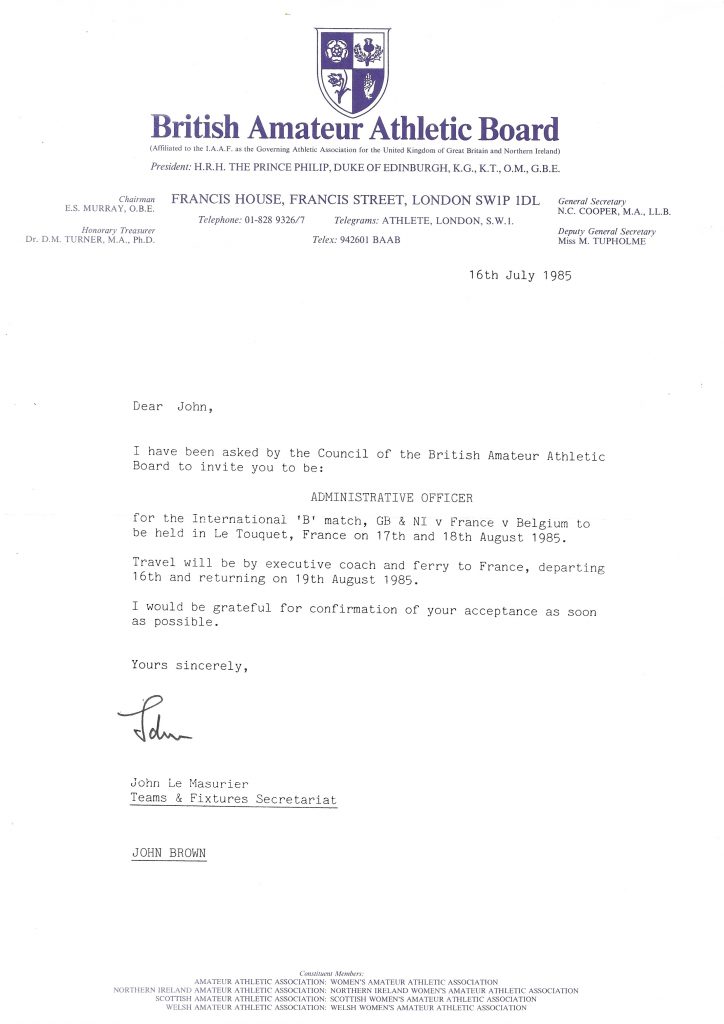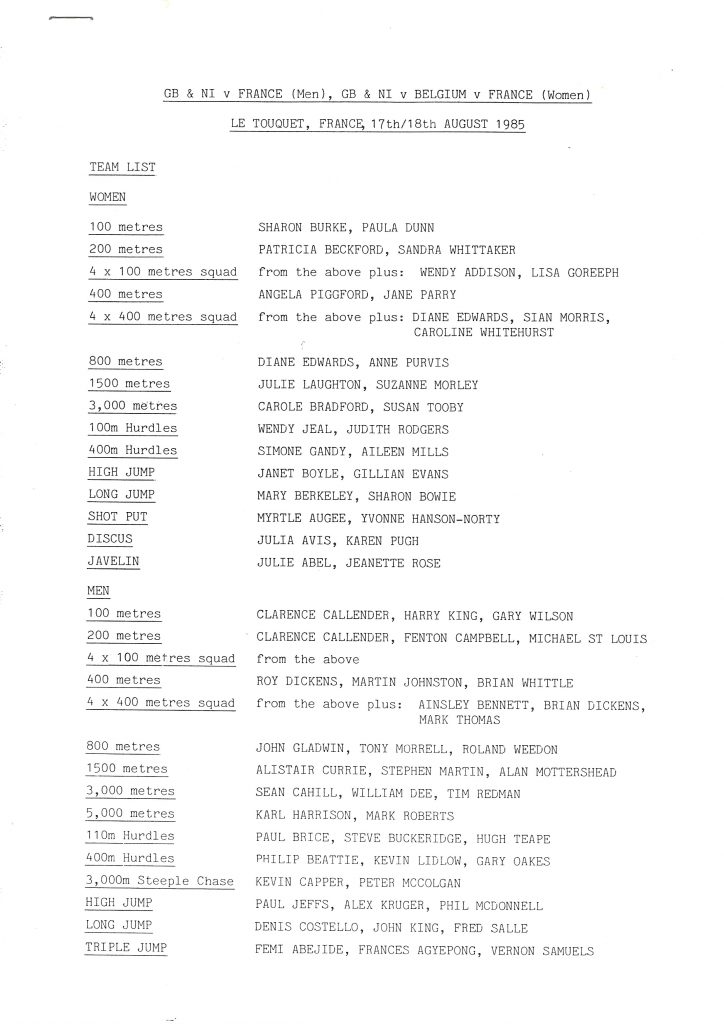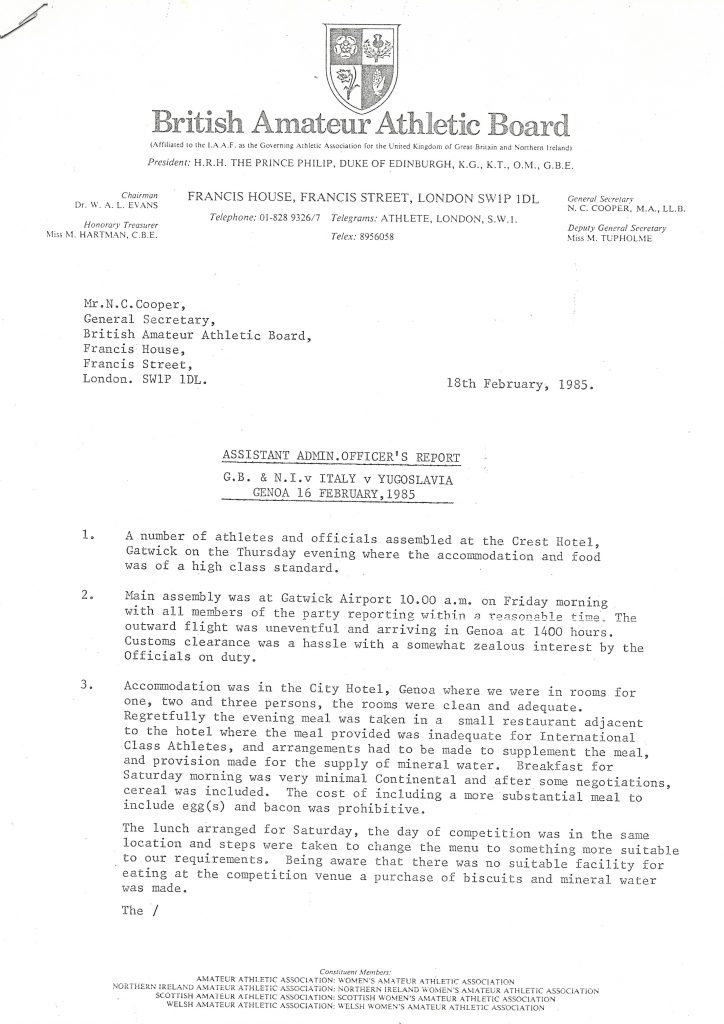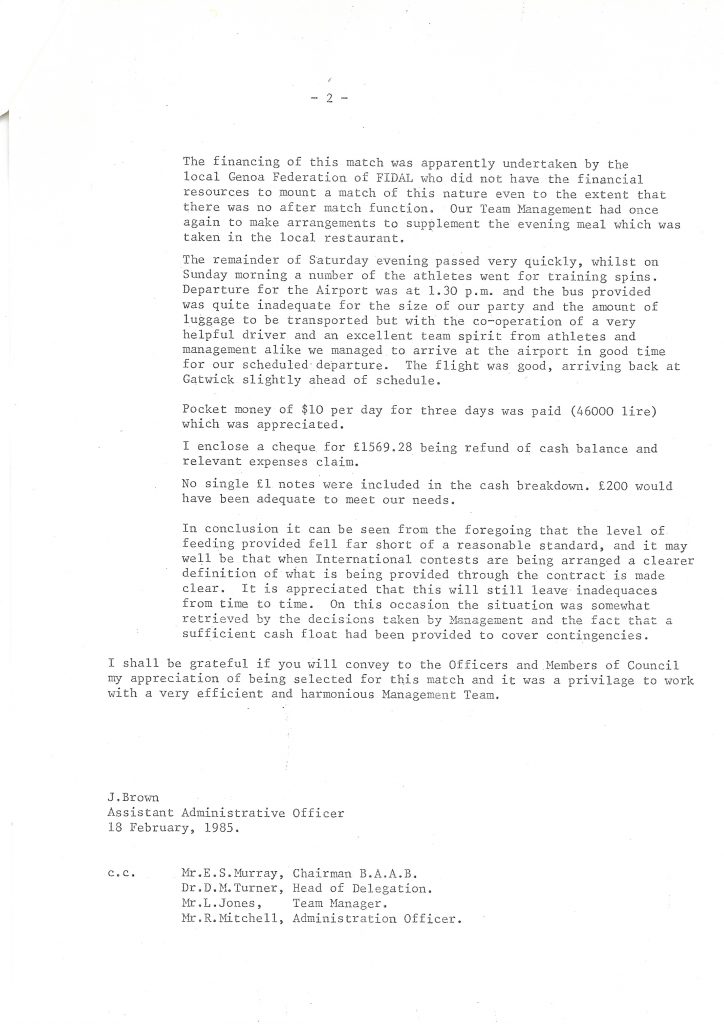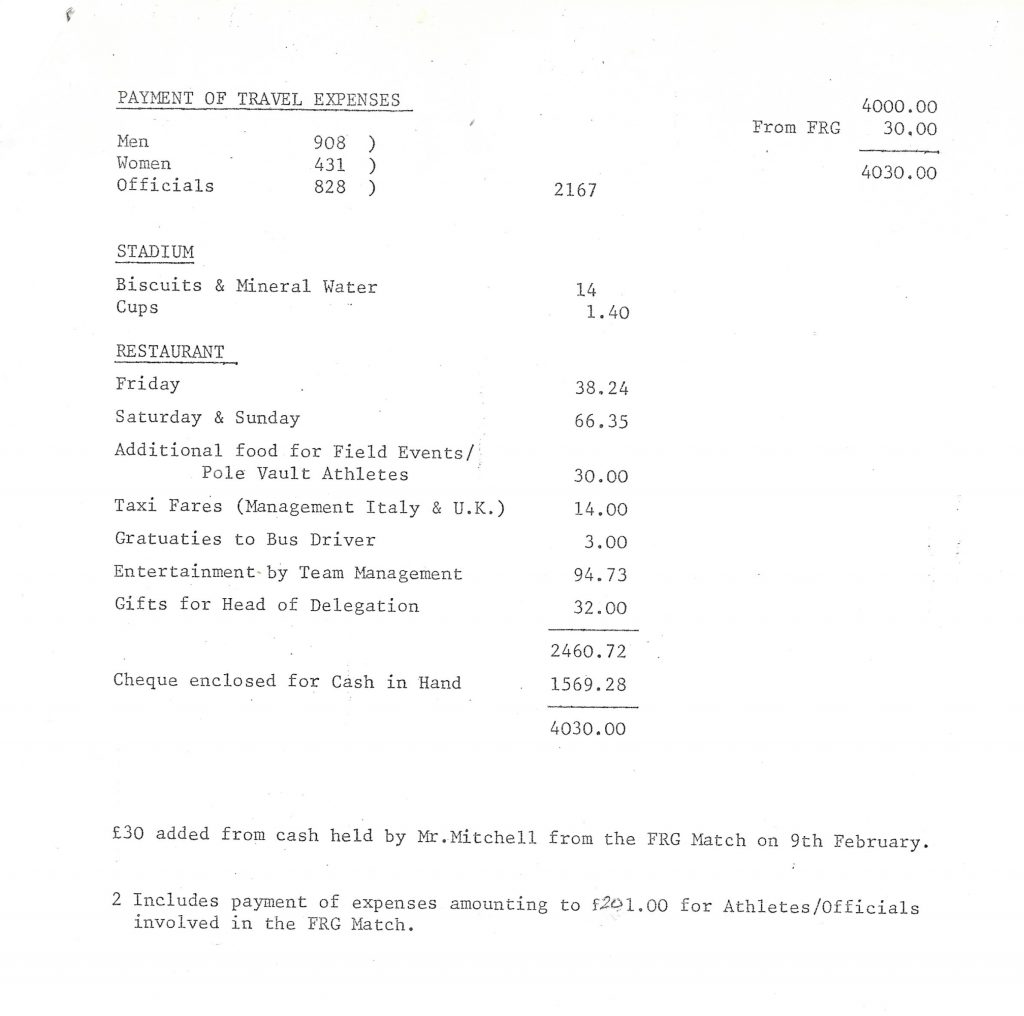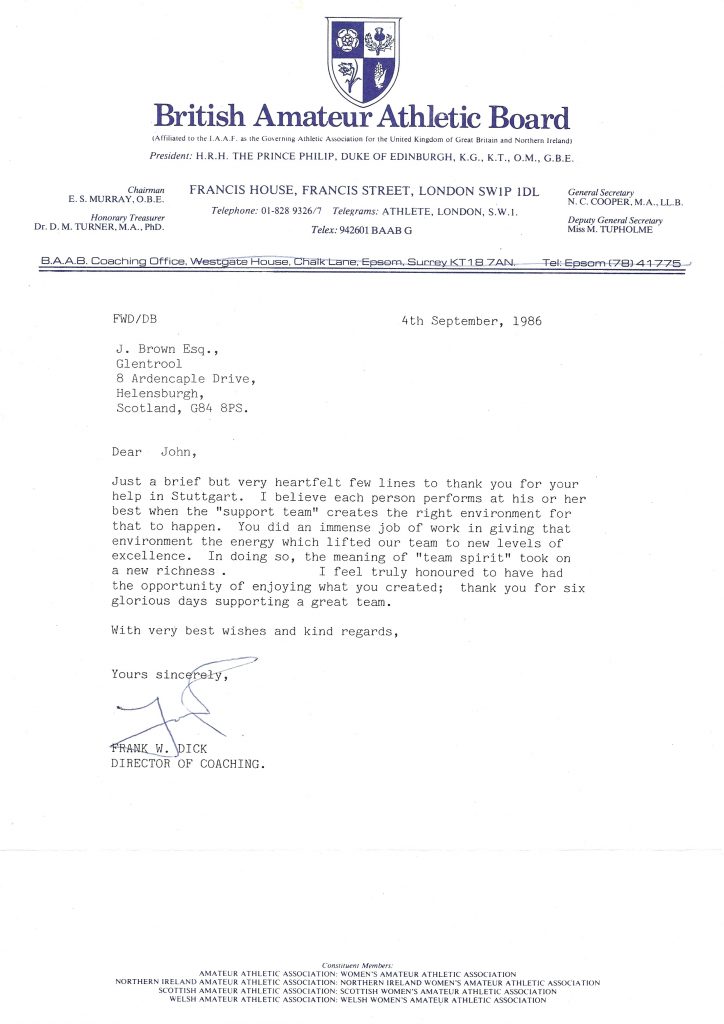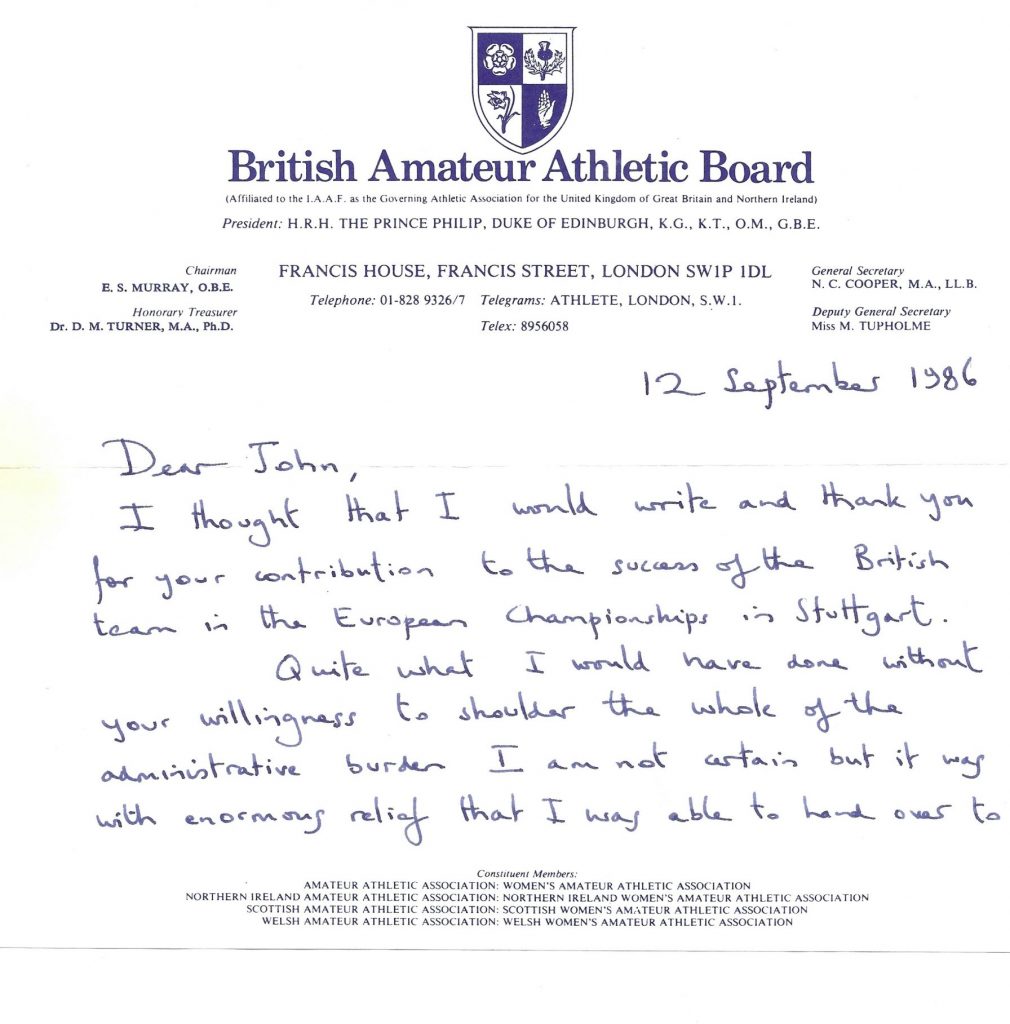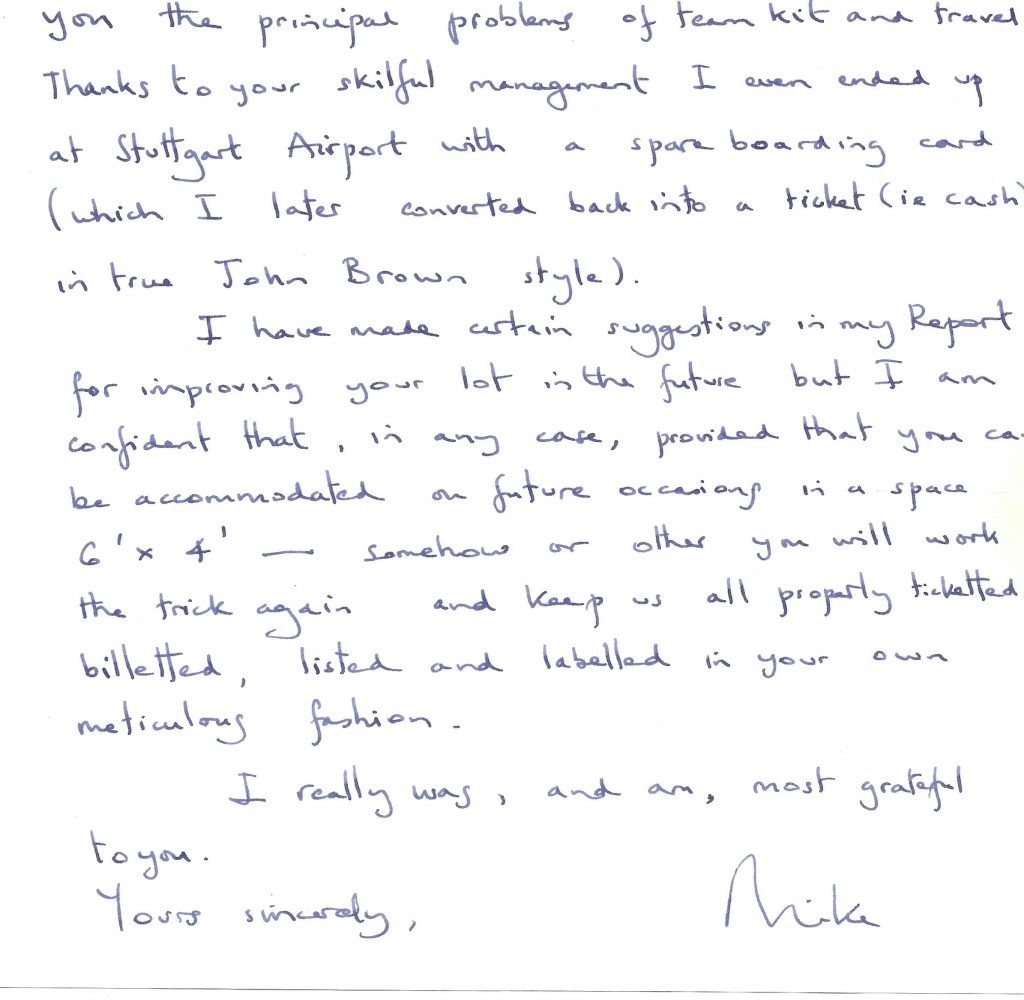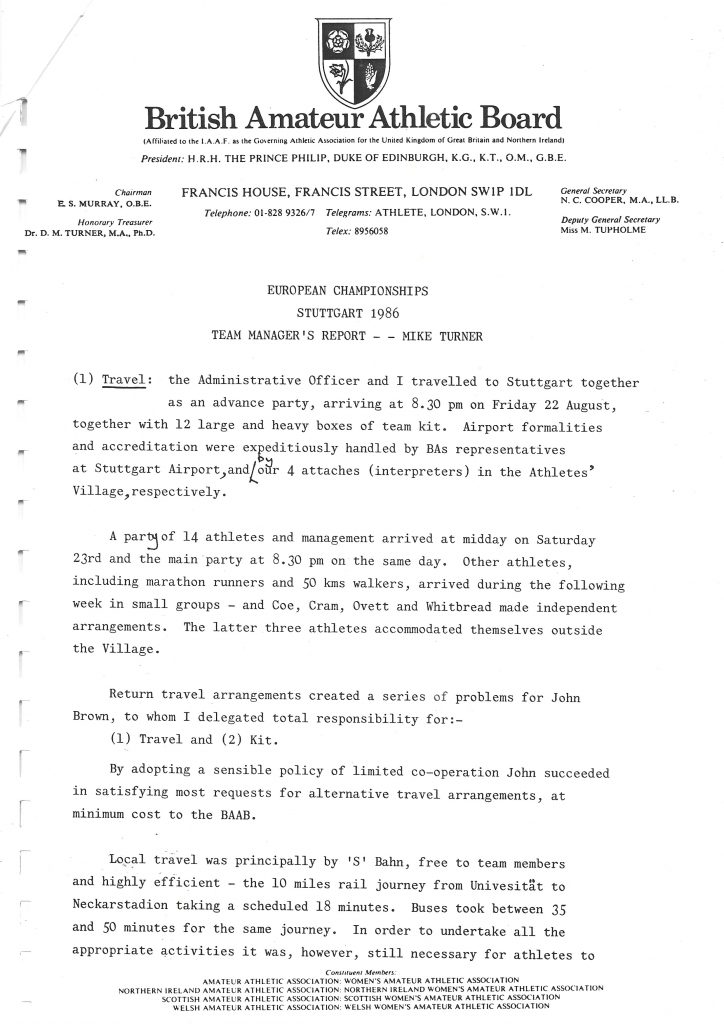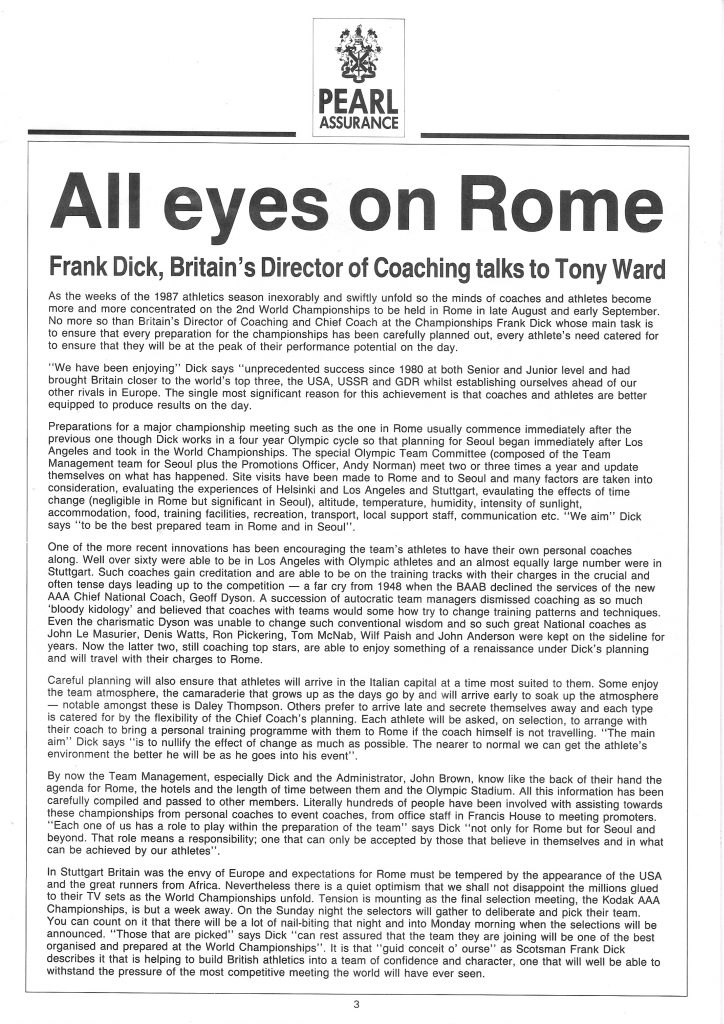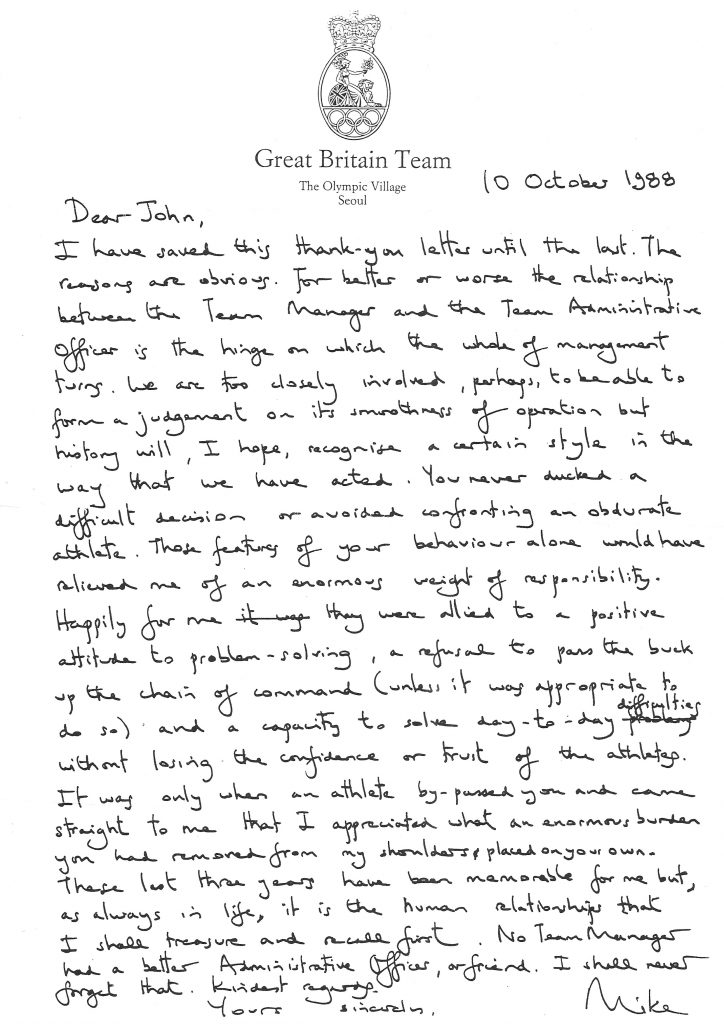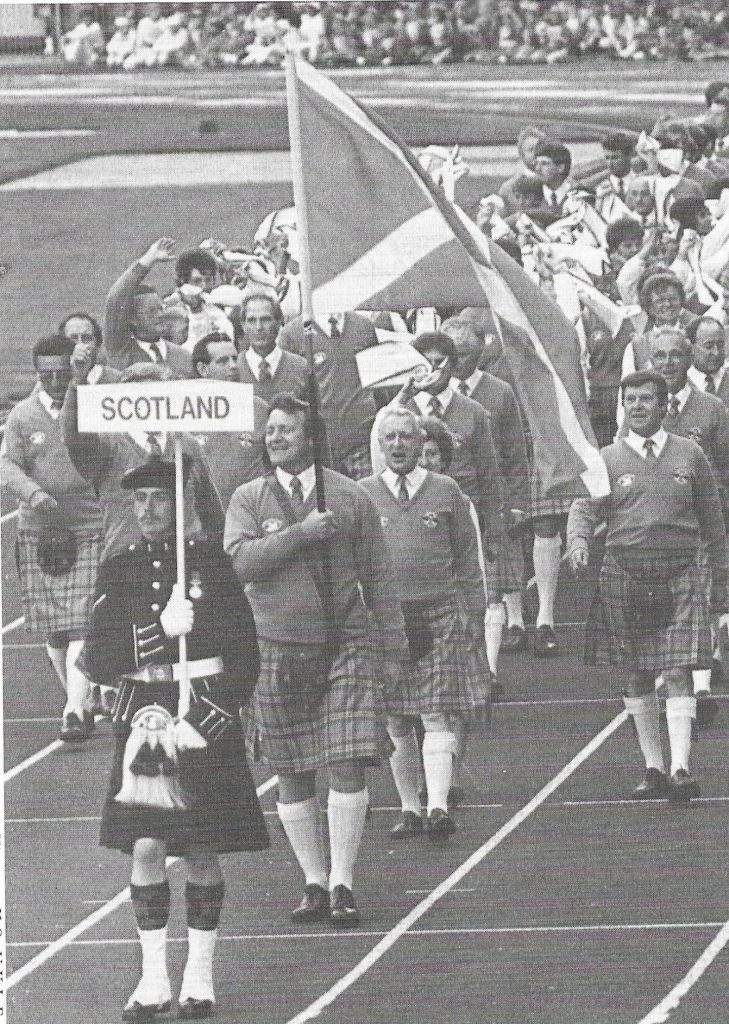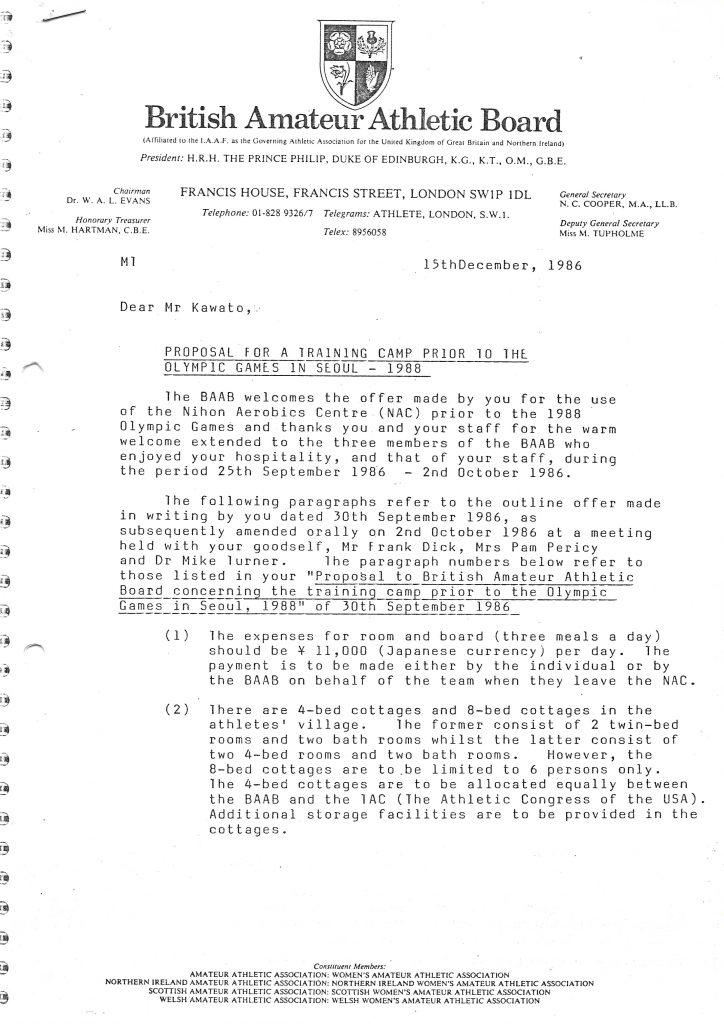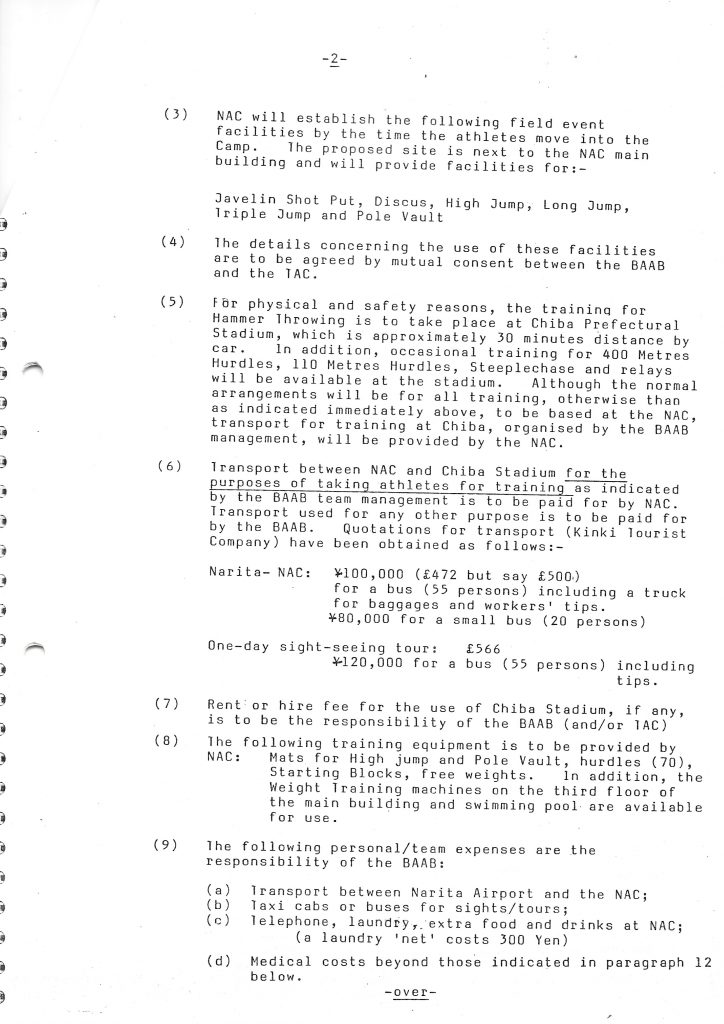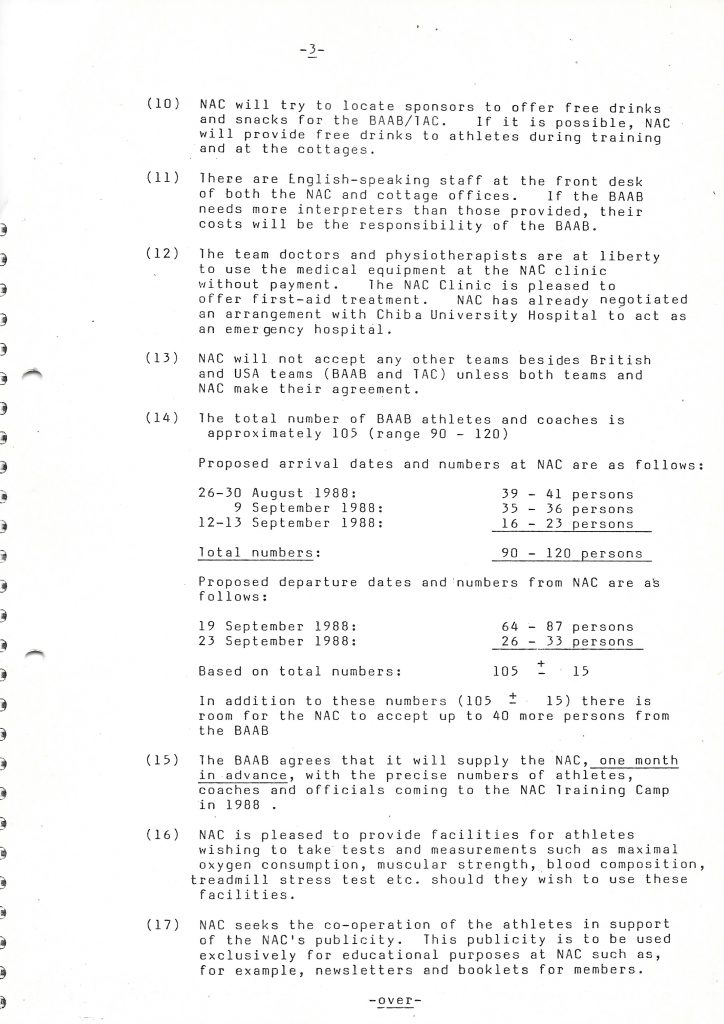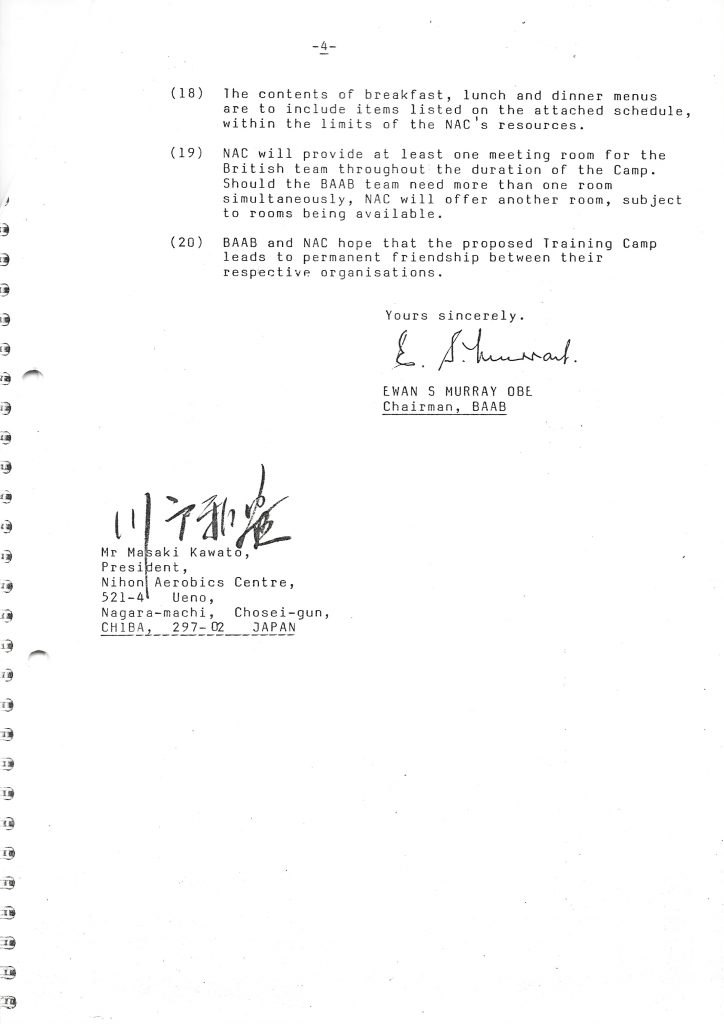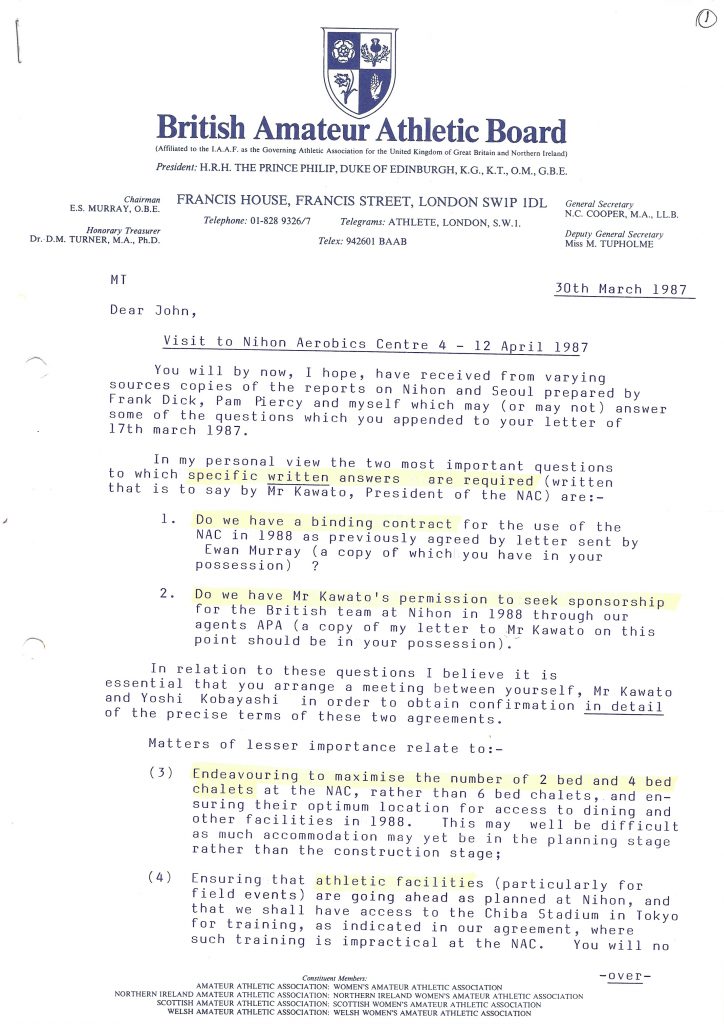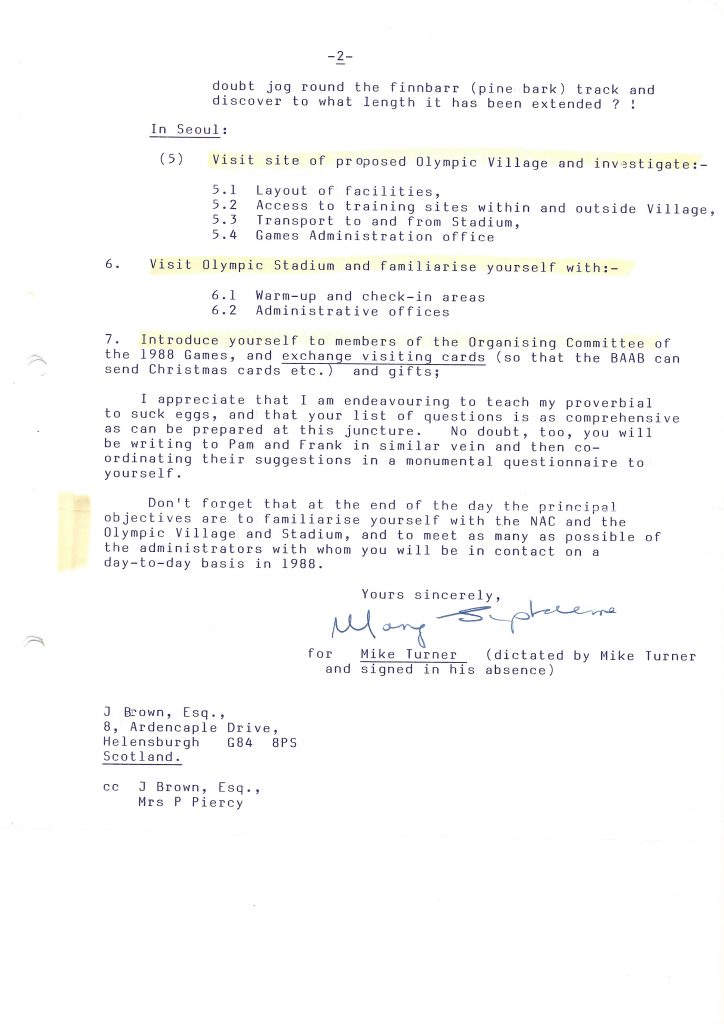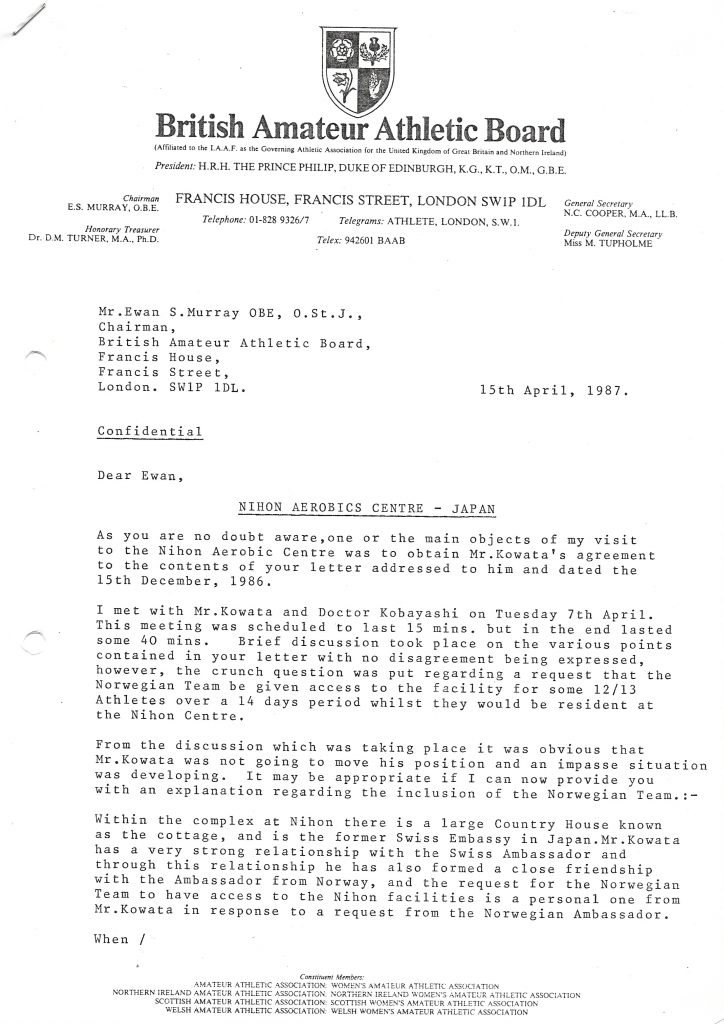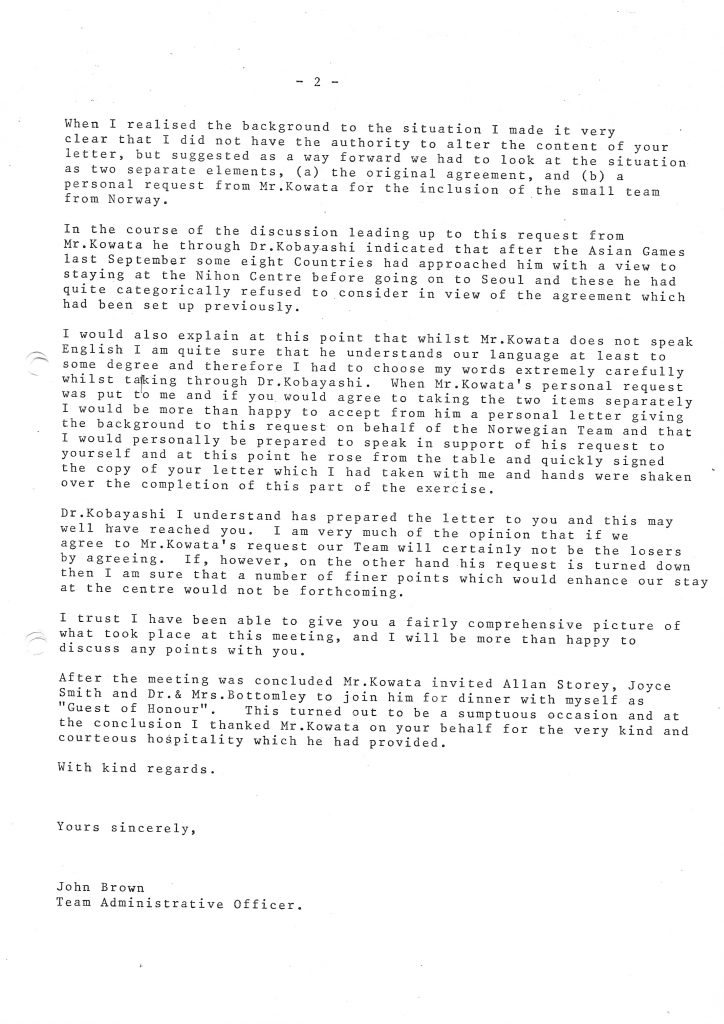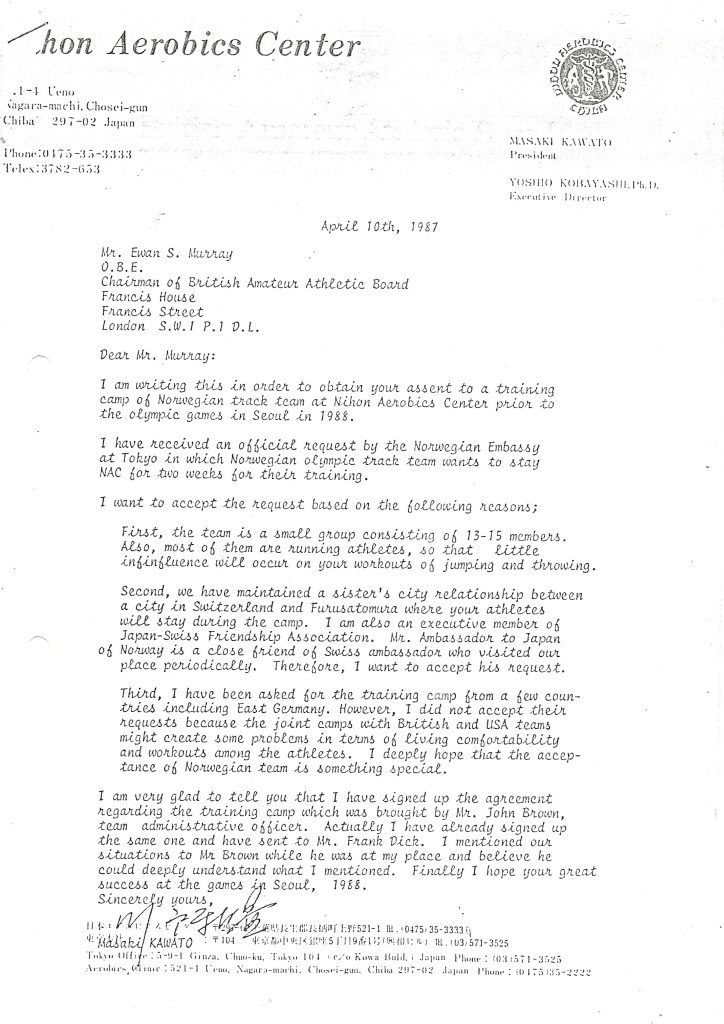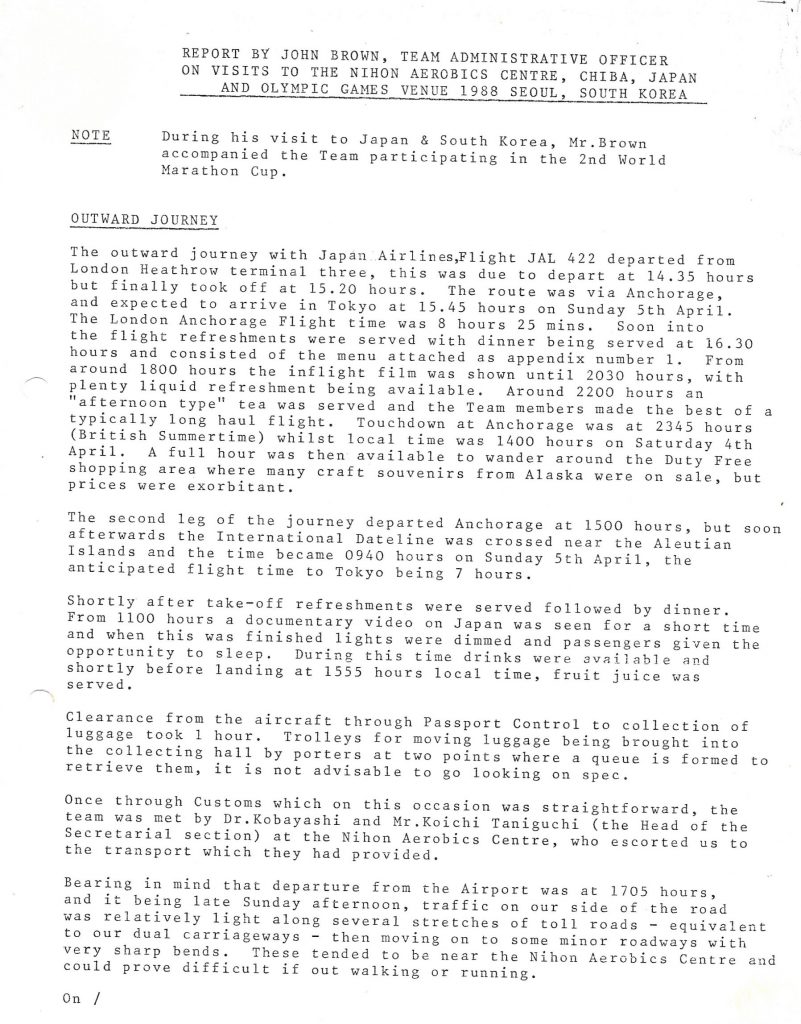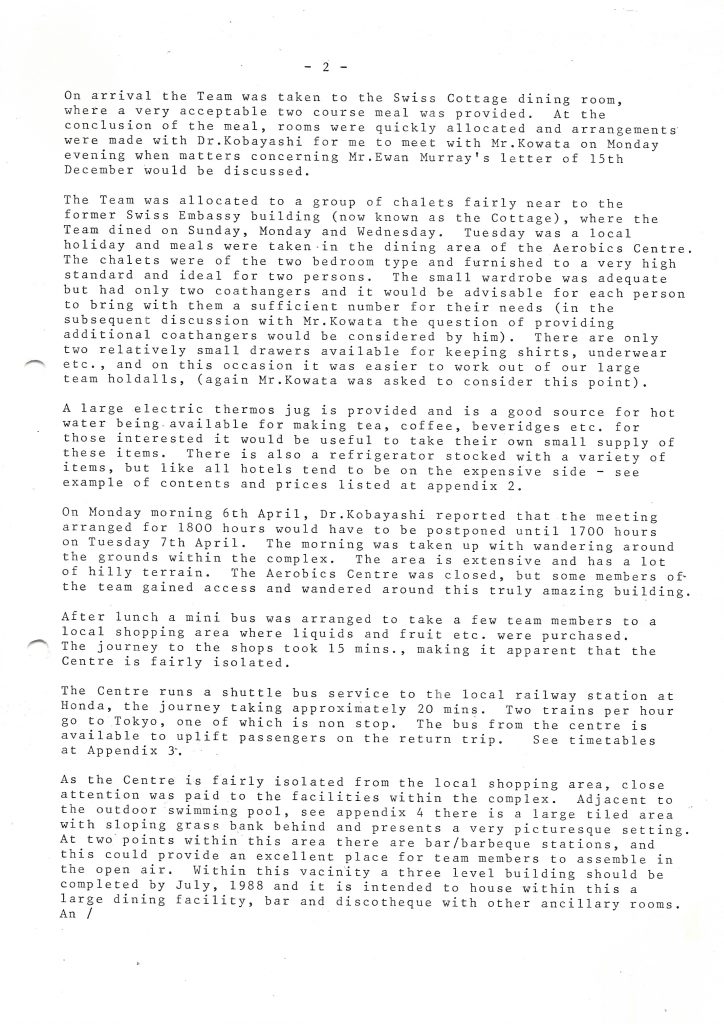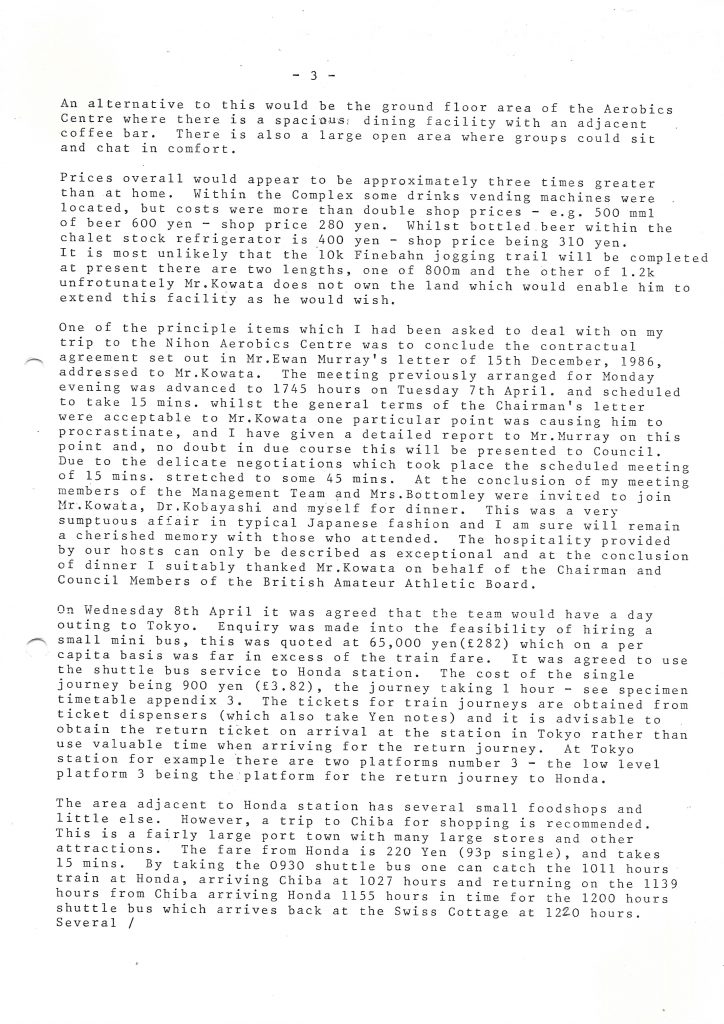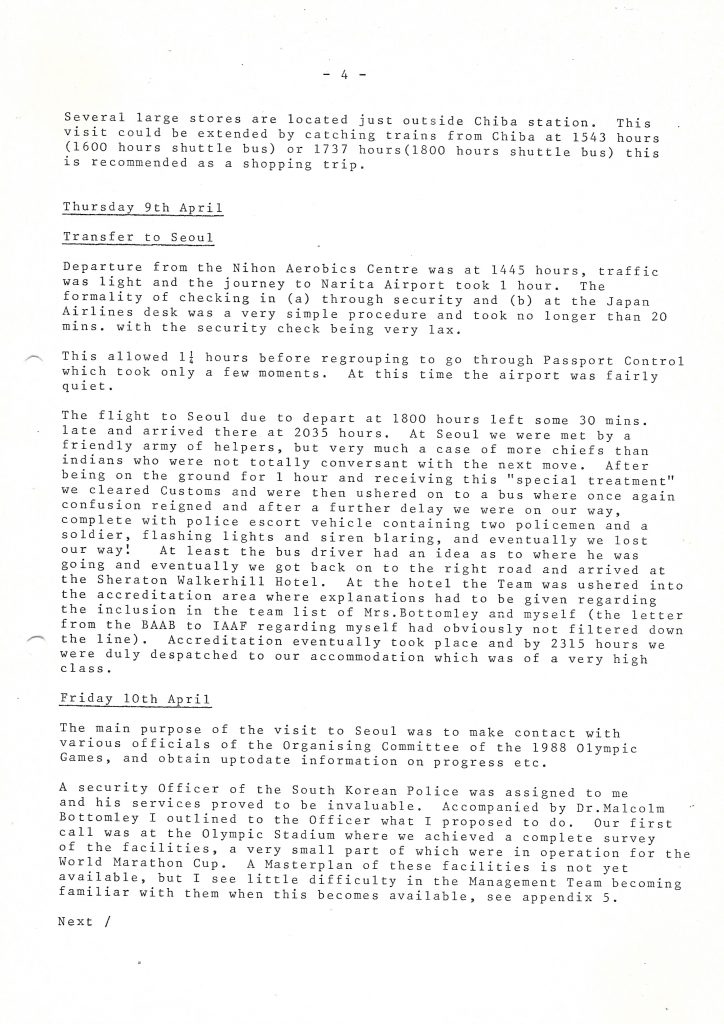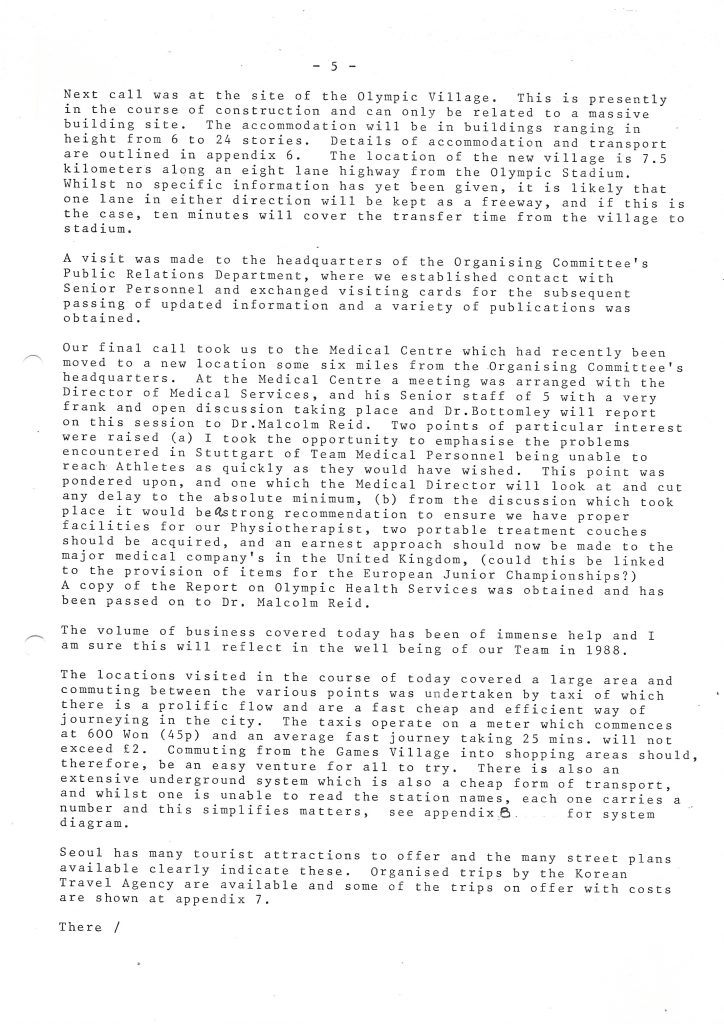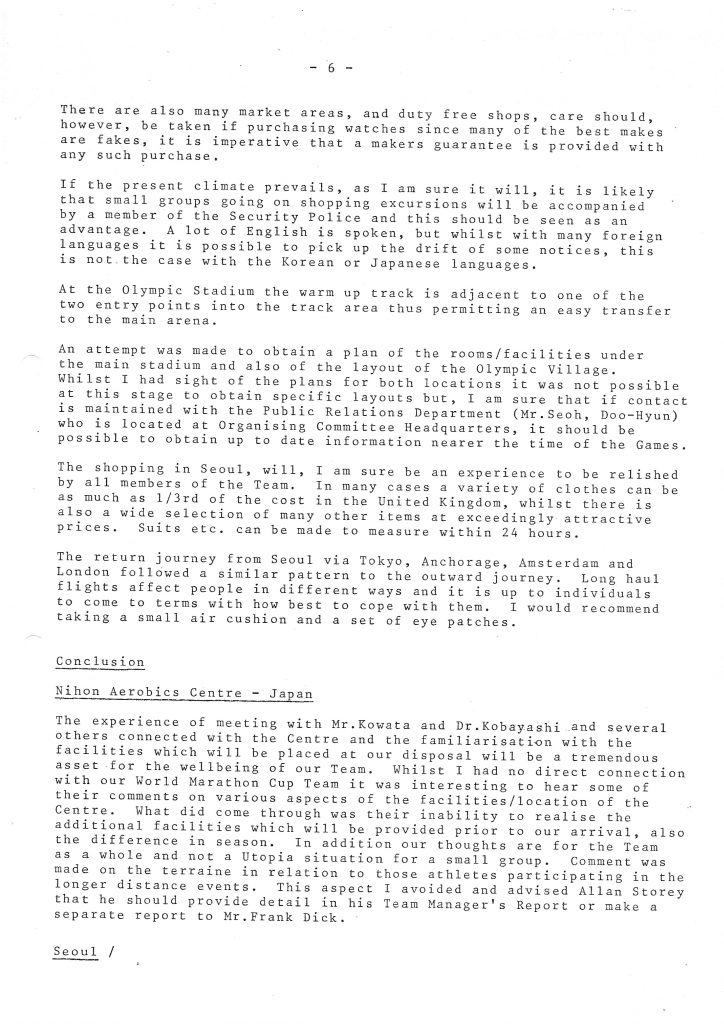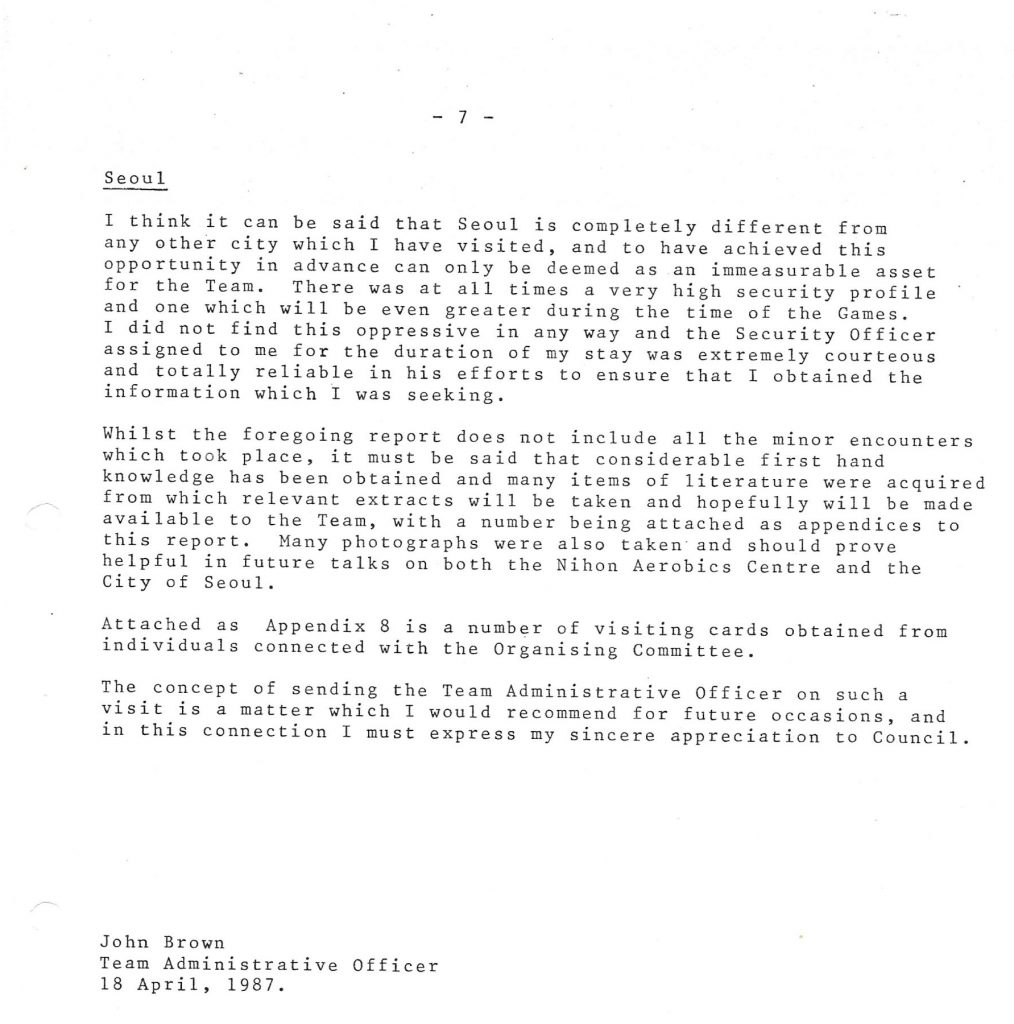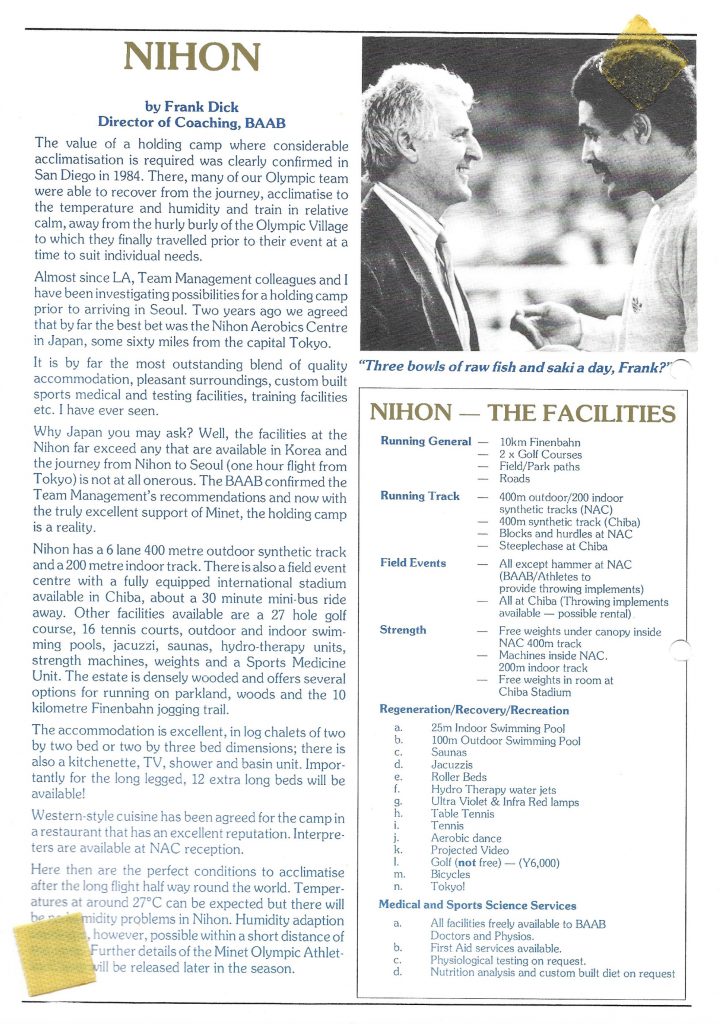A Young Brian Potts in action in the Carnethy 5
Clydesdale Harriers has had good hill runners from at least the 1940’s. Men like twins Jim and Bobby Shields, Ian Donald and many others created a legacy. The hill men and women of the 1980’s and ‘90’s were also quite superb with internationalists like Brian Potts and Ian Murphy, like Christine Menhennet, and with race winners like Cathy Farrell with of course Jim and Bobby featuring strongly. Brian Potts was one of the best, albeit with a short career in the sport. Born in 1962, he was 25 when he joined the club in 1987 but he retired from the sport comparatively early. Why did he, a successful athlete and an internationalist to boot, retire from the sport? The reply is simply that he was injured and could not continue. Diagnosed with anterior compartment syndrome for which the treatment was to have the leg operated on, Brian reluctantly refused the operation and left the sport. He returned briefly in June 1997 when he turned out in the Kilpatricks Hill Race.
He was introduced to the club by John Hanratty who says, “Brian and I worked for Babcock in Renfrew in the1980s. We were both into running and I suggested he came to Clydesdale Harriers. He would leave work and do a training run up Ben Lomond. His preference was hill and country. “
He spoke of his love of the hills and respect for those who took part there, and for all who helped ‘make the sport tick.’ Born on 9th June in 1962, he says he came into the sport initially to keep himself fit. He credits the Shields brothers as having a very positive effect on his running and attitude to the hills. He liked the mountain running scene but how good was he?
A good way of assessing any hill runner’s summer racing season is to look at their performance in the Tiso Championship decided over performances in a set number of races. In 1987 Brian was in fourth position after 4 races with just A Curtis (61 pts), G Kerr (75), and P Marshall (53) ahead of his 44 points with such as D McGonigle, R Morris, D Bell and J Maitland behind him. By the end of the season he was fifth, Alan Farningham having slipped into third place.
- A Curtis 116 points
- G Kerr 113 “
- A Farningham 103 “
- P Marshall 86 “
- B Potts 80 “
- J Maitland 60 “
He was mixing it with the big boys there. Maitland, in sixth, was included here to illustrate that: he was a world class hill and fell runner, orienteer, duathlon and triathlon competitor who became head of the Triathlon High Performance Centre at Leeds Metropolitan University. He may not have run in as many nominated races as Brian in 1987 but it indicates the calibre of athlete with whom he was competing.
He had a good run at Criffel on 15th March to finish seventh behind six very good athletes, on 9thh May he was ninth in the Ben Lomond race and in the Bizzibery run on 20th June he was second in 16:04 over the 3 miles with 500 feet of ascent course, and on another short course Third at the Falkland Festival 3 miles/1200feet on 28th June in 21:10.
The Scottish Hill Runner magazine said after he won the Kaim Hill Race on 15th May, 1988, that “Solid performances in both uphill and downhill sections brought a well-deserved victory to Brian Potts.” Result: 1. B Potts 27:59; 2. A Farningham 28:07; 3. D McGonigle 28:17.
1988 was another good year for him. He ran in and won the Tiso Campsie Race on 29th May leading the Clydesdale team of Andy Dytch (5th), Jim Shields (8th) to first place. On 26th June he won the Falklands Festival run of three miles and 1200 feet. Two days later, 28th June saw him run in the Eildon Two Hills Race and finishing sixth. The Fell Runners magazine reported on the Falklands race: “Heavy overnight rain made the top part of the course fairly slippery. Nevertheless Brian Potts was only 11 seconds outside the course record set by Dermot McGonnigle in 1987.” His winning time was 19:35, one minute and 35 seconds clear of second. On 3rd July he ran in the Moffat Weavers Chase over 18 miles and with 5000 feet of ascent to be fifth finisher. It was a much longer race than the others noted above and he emerged with credit over this distance too.
Brian with Christine Menhennet at Die where they both represented Scotland
1989 was a good year for him on the Hills. The high spot was when he was selected to run in the World Mountain Running Championships at Die-Chatillon-en-Diois in France when he was a member of the team that won third place medals. The team of Colin Donnelly, Brian, John Wilkinson and Ian Davidson was placed on the Scottish Athletics Roll of Honour for this performance in a world championships.
At home he ran well and although not all results are available, the following list, while not comprehensive, gives a picture of the year.
| Date | Race | Position | Time |
| 18th February | Carnethy Five | 3rd | 50:42 |
| 6th May | Ben Lomond | 5th | |
| 10th May | Dumyat | 5th | |
| 17th June | Broadlaw | 10th | 29:47 |
| 21st June | Cort-ma-Law | 2nd | 47:04 |
| 30th July | Half Ben Nevis | 1st | 51:31 |
| 5th August | Creag Dhu | 1st | 28:42 |
And then we add in one of his favourite races, the Tinto Hill race in Lanarkshire, which he won on 1st November in a time of 31:37. It is one that he wanted to win well before it was due to be run and it was as much a triumph for determination as for ability. Three firsts, a second and a third in eight races is pretty good for someone as new to the mountain running scene as he was then.
Brian Potts, second from left, finishing in the National Championships at Irvine. This picture solved a problem for the SCCU because there was quibble about whether the Dundee runner had finished in front of the man in the white vest. This photograph, provided by John Hanratty, solved the problem for them.
1991 saw some very good results starting with his sixteenth place in the Snowdon International on 25th July bringing a third place team medal. Other excellent results that year were victories in Criffel on 10th March where he was 5th, the Kilpatricks Hill Race on 16th June which he won in 52:12, the Half Ben Nevis on 14th July in 52:07 was another victory, and the ‘Fell Runner’ commented on the fact that of the three races that weekend (Cow Hill and Melantee) two had been won by Lochaber runners with the remark that Brian Potts of Clydesdale broke the Lochaber stranglehold on the weekend. There were also second places in the Cairngorm race in 73:26 and the Blisco Dash in Cumbria on 17th July where he was beaten by G Bland with Brian’s time being 38:30.
Having started the year in the Snowdon International, he ran in the World Mountain Running Championships at Zermatt on 8th September where he finished 49th over the short course 11.3 km with 805 metres of ascent.
*
In 1992 he won the Midweek League decided for points won over five races – the Whangie Whiz at Strathblane, Dumyat at Blair Logie, Kilpatricks in Clydebank, Ben Shean at Strathyre and Cort Ma Law at Lennoxtown.
He won the Criffel Hill Race in Dumfries on 15th March, Ben Lomond on 9th May and Ben Sheann on 17th June. (Results from Fell Runner magazine)
There were many other good races that year but nor quite as many as is shown in his 34th place in the 1992 Championship.
Over the country he ran in club, District and National championships and relays including the prestigious Edinburgh to Glasgow eight stage. Brian also represented the club in track and field competitions as part of one of the best teams in the land specialising in the steeplechase which he ran in 1988, 1989, 1992. In 1989 he also ran over the 400m hurdles. His best time for the event was recorded in 1988 when his 9:50.7 ranked him in the top 30 in Scotland. A good club runner? He ran one steeplechase with racing flats on instead of spikes. Landing on and then taking off from a wet steeplechase water jump with wet shoes would indicate that he would not do that by choice but he did it for the club team. Note also that he ran the 400 metres hurdles once, saying it was as a warm up for the ‘chase when really the club needed the points.
When asked what he got from running, he said he liked the feeling of achievement and of meeting people from far and wide. He thought his personal bests were finishing 28th in the world mountain championships in a team which achieved third team bronze medals His general attitude to the sport was that you got out what you put into it. His best ever performance was winning Ben Lomond in 1992 in 1:0854 from Dermot McGonigle in 1:09:06 in afield of 194 runners. When asked what was his worst race, his reply was short and succinct: “None! If I finished down the field there was always a reason.” The only race that he wanted to win but didn’t manage to was the Ben Nevis – but he’s not alone in that one where you are racing the hill and the weather as well as the other runners.
Getting a bit philosophical we asked what running brought him that he would not have wanted to miss and there was no hesitation here either. His response? The people that make the sport tick. Brian is an endurance runner and the question that other runners always ask is about the training that he did to get the results that he got and we asked if he could give some details of his training? “I was doing 70 miles a week which meant running morning and night. Before I won Ben Lomond, I ran it six times prior to the race day , on the race day I turned at the summit and the marshal shouted out 45 mins at that I nearly stopped for a second as I had turned at the summit in 42 minutes in training.”
A Clydesdale Harriers club group after the Dunky Wright race. From right: Charlie McIntosh, Brian Potts, Derek Halpin, John Hanratty, Willie McCoo and Peter Rudzinski
There was more to Brian than the running. Although he was never a committee man, he did help at the ‘Come and Try Hill Running’ days held in Old Kilpatrick run by Christine Menhennet and Denis Bell. Denis says : “Chris Menhennet had the great idea for ‘Come & Try’ and I helped her carry it off at Old Kilpatrick Bowling Club. As I recall about 15 ‘turn ups’ and about 6-8 of us worthies. We did basic introductory stuff and explained the concept of hill running and the organisation in place to assist…I cannot remember if it was still Scottish Hill Running Association, or Hill Running Commission (the fully affiliated SAL organisation). We covered stuff like essential equipment, shoes and bumbag, top coverings, then maps and compass etc…and a few countryside craft hints and tips (eating and drinking etc) all very low key.
We were trying to enthuse ‘new runners’ to hill running, and I recall ‘most’ had some jogging running experience, though generally ‘little’. We set off in small groups to do easy runs up into the Kilpatricks and those were very canny ‘social’ groups, I remember in mine I got them to do a wee scree run descent for fun).”
Picture below from one of these days shows Denis Bell (second left), Christine Menhennet, Brian Potts and Ian Murphy second from right.
CoPilot says about him:
“Brian Potts, a talented runner, made his mark both on the track and the hills. Let’s delve into his achievements:
- Track and Road Running:
- Brian was a good runner on the track and road. He excelled in cross-country races and was particularly outstanding on hilly terrain.
- His favorite hill race was Tinto, where he secured numerous victories and set records.
- Brian represented Scotland in hill running events.
- He also participated in the Island Peaks Race, showcasing his versatility as a competitor.
- Island Peaks Race:
- The Island Peaks Race is a unique event that combines hill running and sailing. Teams consist of both hill runners and sailors.
- The sailing course spans 160 nautical miles along the stunning West Coast of Scotland, including challenging areas like the Corryvreckan and the Mull of Kintyre.
- While sailors navigate the waters, runners cover 60 miles and ascend a total of 11,500 feet during the race.
- Legacy:
- Brian Potts left a lasting impact on the Scottish running community, especially in hill racing.
- His dedication to both track and hills made him a respected figure among fellow athletes.
- Brian’s achievements continue to inspire runners and adventurers alike.
Remembering Brian Potts, a true enthusiast of Scotland’s rugged landscapes and challenging races”.

